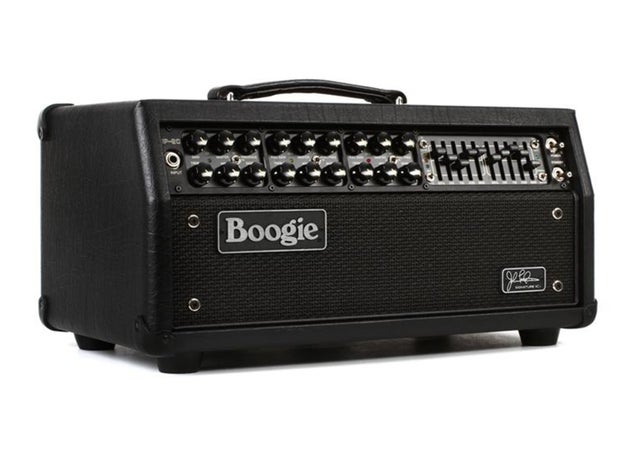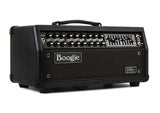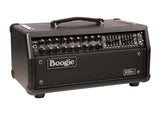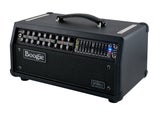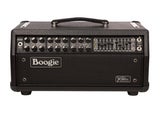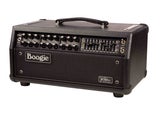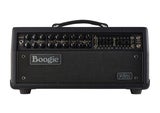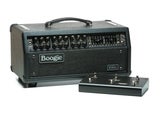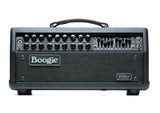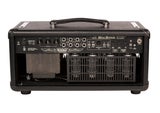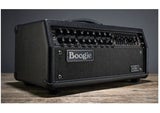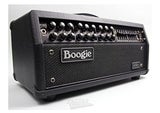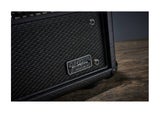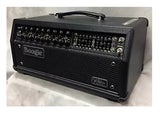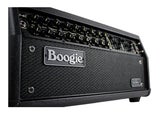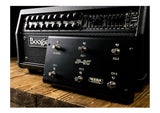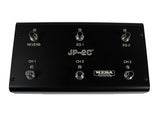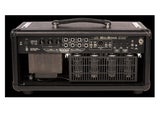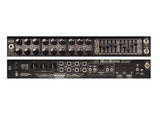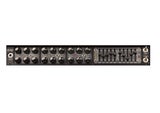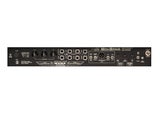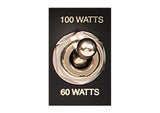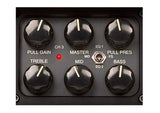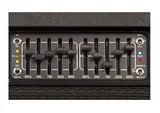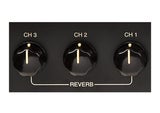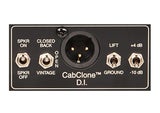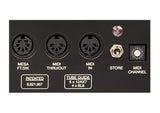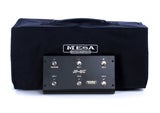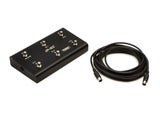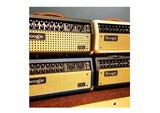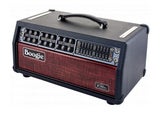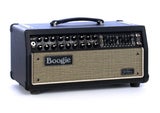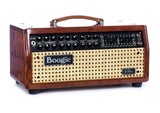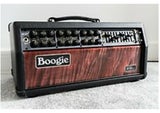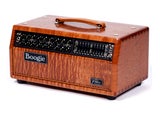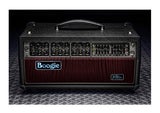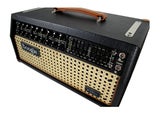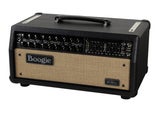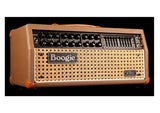- SHOP
- >
- GUITAR AMPLIFIER VALVE HEADS
- >
- BRAND NEW | SEALED BOX
- >
- MESA/Boogie® JP-2C™ Mark IIC+™ John Petrucci Signature 60/100w 3Ch, Dual 5-Band EQ, MIDI-Everything Tube Electric Guitar Amplifier Head (Made in U.S.A.) ★ BRAND NEW | SEALED BOX ★ FREE FREIGHT | 5YR WTY | LIMITLESS LAYBY | MULTIPLE PAYMENT OPTIONS
MESA/Boogie® JP-2C™ Mark IIC+™ John Petrucci Signature 60/100w 3Ch, Dual 5-Band EQ, MIDI-Everything Tube Electric Guitar Amplifier Head (Made in U.S.A.) ★ BRAND NEW | SEALED BOX ★ FREE FREIGHT | 5YR WTY | LIMITLESS LAYBY | MULTIPLE PAYMENT OPTIONS
SKU:
NTM-2.M2CX.BB-N
A$6,295.00
A$5,999.00
A$5,999.00
On Sale
Unavailable
per item
MESA/Boogie® JP-2C™ Mark IIC+™ John Petrucci Signature 60/100w 3Channel, 5-Mode Per-Ch All Tube Electric Guitar Amplifier Head w/- 5 x 12AX7 Pre-Amp Valves and 4 x 6L6 Power Valves, Dual Footswitchable 5-Band EQ, MIDI-Through, MIDI-Switchable Effects, True Spring Reverb, Buffered Tube Effects Loop, CabClone™ Output as well as 8-Button Footswitch, Cables, Slip Cover, Manuals, etc (Made in U.S.A.) 240volts.
★ BRAND NEW | SEALED BOX ★ FREE FREIGHT | 5-YEAR WARRANTY | LIMITLESS LAYBY | MULTIPLE PAYMENT OPTIONS
A$6,295.00 Regular RRP - A$5,999.00 On Sale
SKU: NTM-2.MVCX.BB
∎ MESA/Boogie® JP-2C™ Mark IIC+™ John Petrucci Signature 60/100w 3Channel, 5-Mode Per-Ch All Tube Electric Guitar Amplifier Head w/- 5 x 12AX7 Pre-Amp Valves and 4 x 6L6 Power Valves, Dual Footswitchable 5-Band EQ, MIDI-Through, MIDI-Switchable Effects, True Spring Reverb, Buffered Tube Effects Loop, CabClone™ Output as well as 8-Button Footswitch, Cables, Slip Cover, Manuals, etc (Made in U.S.A.) 240volts.
FREE FREIGHT | FULL 5-Year Manufacturers FACTORY WARRANTY | LIMITLESS LAYBY | MULTIPLE PAYMENT OPTIONS | NO INTEREST EVER Finance available.
● Shhhh! . . . We are Australia's Cheapest - ONLY AU$5,999.00 ! ! !
● Regular New Price is AU$6,295.00 RRP ! ! !
● CRAZY - A FULL 15% OFF ! ! !
The ultimate evolution of the legendary MARK IIC+™ circuit!
Introducing the JP-2C™ Head from MESA Engineering® - The ultimate evolution of the legendary MARK IIC+™ circuit!
We're celebrating our 30-year relationship with luminary guitarist John Petrucci, by introducing the JP-2C™… John owns an extensive collection of MESA® gear and has recorded & toured with the most iconic MESA® products of the past three decades. If you were to look for a world's foremost authority on MESA® gear, no doubt John Petrucci would be in the running for that title. So, what would a player of his calibre and knowledge ask for in an amplifier, if he could have anything? The JP-2C™ is the answer to that question.
JP fans know that the legendary Mark IIC+™ circuits have been favourites of his. So, is this amp a IIC+™? YES… it’s the next generation Re-Issue of the legendary amp so many players the world over covet and search to find.
The JP-2C™ offers the renowned tones of the IIC+™ yet provides elements unimagined at the time of the original's design.
This IIC+ is MIDI Switchable/Programmable via Control Change and Program Change messages
Two 5-Band Graphic EQs are on board and each are Footswitchable or Channel Assignable.
MESA®'s CabClone™ Cabinet Simulator technology is built right in and provides a way to capture true amplified guitar sound, with pro studio grade sound quality and realistic feel, without the need for a mic or a cabinet.
Our Mid/Boost (patent applied for) is found on Channel 1. It doubles as a standard Midrange Tone Control from 1 to 5 and a Variable Gain Boost Control from 5 to 10, providing precise levels of sweet harmonic overdrive, from subtle to blistering.
____________________________________________________________________________
WHAT'S IN THE SEALED BOX:
The Home of Tone®
Over 20 years have passed, two generations of guitarists and several musical trend-cycles since the Dual Rectifier® first unleashed its crushing wall of gain on radio. In that time many have mimicked, modelled, dissected and plagiarized it, but it remains firmly planted at the centre of hard-core… a rock icon. Still leaving the widest, deepest footprint in heavy music and now a long list of chart-topping devotees outside the world of heavy, the Rectifier series has grown to include several now famous heavies like the Triple Rectifer®, Road King®, Roadster®, Mini Rectifier®, and Recto®-Verb 25. Welcome to the Rectifier® Series, a line of MESA/Boogie® amplifiers that have shaped modern guitar tone, forever glorified in recording history, influencing guitar amplification technology from the day they were launched on the scene to this very day.
____________________________________________________________________________
Features
● Made in Petaluma, California with the world’s finest materials
● All-Tube Amplifier: 4x6L6 Power Tubes / 5x12AX7 Preamp Tubes
● Class A/B Power Amp delivers exceptional power, punch & clarity
● 100/60 Watt Selectable Global Power Switch
● Fixed Bias for consistent, maintenance free performance
● 3 Fully Independent Channels with 5 Modes:
- Channel 1: Mark IIC+™ Clean - Independent Gain, Treble, Mid/Boost (patent applied for; doubles as a standard Midrange Tone Control from 1 to 5 AND a Variable Gain Boost Control from 5 to 10, providing precise levels of sweet harmonic overdrive, from subtle to blistering), Bass, Presence, Reverb (rear panel), Assignment Switch for Dual 5-Band Graphic EQs (EQ 1 or
EQ 2 - On, Off or Footswitchable) & Master Controls
- Channel 2: Legendary Mark IIC+ Lead or Shred Modes - Independent Gain w/Pull Gain Boost, Treble, Middle, Bass, Presence w/Pull Frequency Shift, Reverb (rear panel), Assignment Switch for Dual 5 Band Graphic EQs (EQ 1 or EQ 2 - On, Off or Footswitchable) & Master Controls
- Channel 3: Legendary Mark IIC+ Lead or Shred Modes - Independent Gain w/Pull Gain Boost, Treble, Middle, Bass, Presence w/Pull Frequency Shift, Reverb (rear panel), Assignment Switch for Dual 5 Band Graphic EQs (EQ 1 or EQ 2 - On, Off or Footswitchable) & Master Controls
● Two 5-Band Graphic EQs, each are Footswitchable or Channel Assignable
● Footswitchable All-Tube, Long-Tank, Spring Reverb with ● Independent Channel Control (rear panel)
● Fully Buffered, Tube FX Loop (MIDI Switchable)
● Built-In CabClone™ Cabinet Simulator Output featuring: Closed-Back, Open-Back and Vintage Voices / Internal Amp Load & Headphone Output / Speaker On/Off & Ground Lift Switches / ● Selectable +4 or -10 Output Level Switch
● MIDI Switchable/Programmable via Control Change and Program Change messages (MIDI IN, MIDI Thru/Out, MIDI Channel & Store Switches) – Controls Channels 1, 2, 3, EQ 1, EQ 2, Shred, Reverb & FX Loop
● Slave Output
● All Aluminum Chassis.
● New 3x3, 6 Button Footswitch (Bottom Row: Channel 1, Channel 2, Channel 3 – Top Row: Reverb, EQ 1 & EQ 2)
● Slip Cover
____________________________________________________________________________
MESA® and Petrucci
Bring You the Return of the IIC+™
The MESA® John Petrucci Signature JP-2C™ tube electric guitar amplifier head gives you all of the tonal variety and power of a Mark IIC+™ with powerful additions specified by John. It's a celebration of John and MESA®'s 30-year relationship and is based on one of MESA®'s fan-favourites. And the JP-2C™ features additions like dual footswitchable 5-band EQs and a CabClone™ output, making it an even more powerful animal. The MESA/Boogie® JP-2C™ Mark IIC+™ brings back a legendary amplifier design with new powerful additions.
MESA/Boogie® JP-2C™ Mark IIC+™ Tube Electric Guitar Amplifier Head at a Glance:
● A Hard-rocking History
● Sonic versatility
● Amp adjusts to your needs
A Hard-rocking History
John Petrucci has been using MESA/Boogie®s tube amplifiers since the very early days of Dream Theater, and the JP-2C™ is a celebration of those three decades. The amp is based on MESA's highly sought-after Mark IIC+™ that was the identifiable sound of John's guitar for many of those years. It has also been used by other well-known hard rock acts, as well as session musicians who have come to rely on the amps' liquidly overdriven tone. Sweetwater is extremely happy to offer these amps and be part of the legacy.
Sonic versatility
The original Mark IIC+™ amps were beloved for their high-gain sound and clear cleans. Both of those sounds are very much on display in the JP-2C™. But the amp's three completely independent channels with five modes each let you dial in any shade of tone from mild crunch to over the top, from warm and round to aggressive and cutting. And the onboard 5-band equalizers let you further sculpt your tone to taste. And even with all of this control, the layout is done to make pulling up your favourite sounds intuitive and fast.
Amp adjusts to your needs
The original Mark IIC+™ amps were just the springboard for John Petrucci when designing the JP-2C™. John also included features like a CabClone™ speaker-emulated line output, 60- and 100-watt operation, and MIDI programmability to make the amplifier even more versatile, and a great tool for the recording and touring guitarist. Dual 5-band equalizers are footswitchable to get three distinct sounds for each channel at the tap of a toe. And the included footswitch also controls reverb, channel switching, and much more.
MESA/Boogie™ JP-2C™ Mark IIC+™ Tube Electric Guitar Amplifier
Head Features:
● John Petrucci Signature Mark IIC+™ amp head from MESA/Boogie®
● Tones based on the legendary Mark IIC+™ amp heads
● Three fully independent channels
● Five modes per channel for even more tonal options
● Dual footswitchable 5-band EQs
● True spring reverb
● 100- and 60-watt operation
● MIDI switchable and programmable
● Buffered tube effects loop
The JP-2C™ Mark IIC+™ delivers iconic amp tones with modern features.
____________________________________________________________________________
Tech Specs
Type: Tube
Number of Channels: 3
Total Power: 100w/60w
Preamp Tubes: 5 x 12AX7
Power Tubes: 4 x 6L6
Reverb: Yes, long tank spring reverb
EQ: 3-Band EQ Per-Channel, Dual 5-Band Graphic EQ
Inputs: 1 x ¼"
Outputs: 4 x ¼" (4/8/16 Ohms), 1 x ¼" (Headphones), 1 x ¼" (Slave Out), 1 x XLR™ (CabClone™ DI)
Effects Loop: Yes, buffered tube driven
MIDI I/O: In, Out/Thru
Footswitch I/O: Yes, (Ch 1, Ch 2, Ch 3, Reverb, EQ 1 & EQ 2)
Construction Material: Baltic Birch with Black Tolex
Power Source: Standard IEC AC cable
Height: 9.25"
Width: 18.75"
Depth: 10.87"
Weight: 40 lbs.
Manufacturer Part Number: 2.M2C.BB
____________________________________________________________________________
A LEGEND, 30 YEARS IN THE MAKING
If you play electric guitar, chances are you’ve heard of John Petrucci and Dream Theater. You may even know of our 30-Year relationship building many of his favourite amplifiers – the very same amplifiers you might have chosen for your sound. This distinguished list includes the MARK IIC+™, Dual Rectifier®, TriAxis™, MARK IV™ and MARK V™ to name a few.
In celebration of John’s talent, his life-long dedication to our shared art, and the long relationship we’ve enjoyed with him, we are proud to introduce a MESA® first; The JP-2C™ - Our first unlimited-build Signature Amplifier.
And YES… it’s a MARK IIC+™! A next generation Re-Issue of the legendary amp so many Recording Artists, MESA® enthusiasts and Tone Freaks the world over covet, often searching high and low to find. Only THIS IIC+™ pulls in an enhanced feature set born from our collaboration with John over a period of three decades of research and development.
SIMPLICITY IN DESIGN
Much like a race car or fighter jet, the JP-2C™ strips down to bare essentials to get the job done effectively, in the simplest way. It’s a purpose-built, no compromise rendering that aims at one single goal; deliver the most aggressive, purest sounding IIC+™ EVER in a versatile package that delivers the goods to meet John’s recording and stage needs. All Things Heavy! But more specifically; the highest headroom Clean sound possible, a Crunch rhythm that has Lead Channel gain available, but is tight, grinding, and articulate, and the ultimate Boogie® Lead Channel with access to even more saturation and the ability to track any technique and speed while also reaching to the stratosphere for single note solos.
In that spirit, unlike other MESA® amplifiers, the JP-2C™ foregoes the concept of multiple voicing Modes derived from other MESA® circuits and instead dedicates each of the three Channels exclusively to circuit voicing’s of the MARK IIC+™, including the new SHRED Mode, which further enhances the top end harmonic layering of the original IIC+™ Lead Circuit.
CHANNEL 1 - DEDICATED TO CLEAN
Channel 1 is dedicated to Clean sounds and is optimized for the maximum headroom possible in the preamp section. Power section clip may be employed to attain some degree of overdrive in Channel 1, albeit at very high volumes due to the 100/60-watt rating of the JP-2C™ power section. Additional “drive” may be sought in the upper region of the MID control (above 12:00 noon) as the MID pot employed here is the same value and taper as our MID/BOOST control found on some of our newer MARK SERIES amplifiers. However, increased headroom in the preamp reduces the amount of overall “gain-boost” available as compared to our other amplifiers with this feature. This fact renders this more powerful MID control as just that… a MID that has increased range to add more midrange frequencies and a “cleaner” gain-boost into the mix.
CHANNEL 2 – EVOLUTION OF THE ORIGINAL MARK IIC+™ CIRCUIT
Channel 2 is the JP-2C™’s Crunch generator. This Channel is all about aggressive, tight overdriven rhythm sounds delivered with amounts of Gain usually associated with Lead Modes or Channels. It IS in fact a Lead Channel… the LEAD Channel from the MARK IIC+™ in its original state circuit-wise. The setting of the Gain has been optimized for its performance in this category of sounds and though it can definitely be used for Lead sounds of all kinds, it is perhaps the best choice when dedicating a Channel in the JP-2C™ to Crunch rhythm work.
To achieve the most famous, now classic MARK IIC+™ grinding rhythm sounds in Channel 2, you can now employ one of two 5-Band Graphic Equalizers…yes, here in the JP-2C™, you have a separate EQ for each of the high gain Channels! This means greater flexibility and improved accuracy when crafting your sounds and allows you to arrive at a truly no-compromise set of sounds for both rhythm and lead! This was something that was impossible on the original MARK IIC+™, hence the fact that many top Artists of the day used two MARK IIC+™s and a MIDI switcher (also contained here) in a rack system to call up dedicated amps with different settings for each sound.
In both Channels 2 and 3 of the JP-2C™, we have removed the VOLUME 1 Control and the LEAD MASTER control from the Panel Layout as compared to the LEAD Mode of the original MARK IIC+™ in favour of user simplicity. The LEAD MASTER is a largely redundant control here in the JP-2C™ and its setting has a very minimal role in the sound. The VOLUME 1 is a bit more sensitive and critical, and here in the JP-2C™ it is pre-set internally (as we did in our MARK V™) to its optimum setting for each Channel. The end result for the user is an amplifier that is MUCH easier to dial and arrive at the very best of the MARK IIC+™’s most signature and mind-blowing sounds more quickly and with less “neurotic tweaking” required. There is NO compromise of the original’s performance and yet a SERIOUS benefit in the dial-ability of the JP-2C™.
CHANNEL 3 – HIGH GAIN SUSTAIN AND EXPLOSIVE ATTACK
Channel 3 is created with soaring lead sounds in mind. Our first priority was to meet and even exceed the incredible explosive attack, blistering sustain and harmonic complexity of the very best of the MARK IIC+™. We, along with the amplifier’s namesake, feel we have achieved exactly that. Channel 3 boasts all the nuanced performance of the originals and delivers it with unbelievable authority due to the 100-watt Class A/B (versus 90-watt Simul-Class™) power section. This difference in power section serves John’s musical style extremely well - In fact, his absolute favourite amplifier of the many IIC+™s he owns is a 100-watt model. Channel 3’s character is therefore a little warmer, fatter and compressed and this plays well into its intended application for lead work of all styles and gain requirements.
FEATURE OVERVIEW
60 OR 100 WATTS – THE HEART OF THE ORIGINAL MARK IIC+™
A long-time MESA® feature, directly off the classic MARK IIC+™ and at the heart of this amplifier is the 60/100 Power Switch. One of the very first “modern amp” features MESA® pioneered in the late ‘60s, this switch puts the centre two power tubes in Standby Mode and allows you to operate at a reduced power setting. This is great for smaller venues, rehearsals, increasing power tube life by swapping and, also imparts a slightly brighter, snappier response that some find desirable. It also allows more power tube saturation at lower volume levels for those who may find that preferable. Either way, the 60/100 switch adds versatility and options to the already impressive arsenal here in the JP-2C™.
PULL SHIFT - MODIFIED TO PULL GAIN & PULL PRESENCE
In addition to the VOLUME 1 and LEAD MASTER control deletions from the original circuit, we’ve modified the PULL SHIFT feature layout of the original IIC+™ to both simplify and enhance both high gain Channels 2 and 3. All PULL SHIFTS that were possible in the original IIC+™ LEAD Mode are internally set to their optimized settings based upon the historical polling of savvy MARK IIC+™ aficionados, artists, and the MESA® Design Team.
In addition to these changes to the original circuit, we have added two new PULL SHIFT options on the JP-2C™. A PULL GAIN on the GAIN control and a PULL PRES (shift) on the PRESENCE control.
PULL GAIN increases the setting of the internally set VOLUME 1 control by approximately one number setting’s worth… in other words, just a little bit. This means that it is added to the already pre-set amount of gain/drive that is in place when the pot is NOT pulled out. In both Channels this PULL GAIN feature allows a little boost of gain for specific musical styles.
The PULL PRES feature located on the PRESENCE controls allows two very different Presence frequencies to be selected. When PULLED, the time-honoured frequency we have used for 45 years appears, which allows control over a much higher range of top end than that of the TREBLE control. When left PUSHED-IN, the PRESENCE control operates on a lower frequency that is still above the TREBLE but adds “increased cut and focus” lower than the traditional PRESENCE that, at times, can sound more cohesive for high gain Crunch rhythm sounds.
GRAPHIC EQ x 2
The ONLY switch in each of the three Channels is the assignment switch for the two 5-Band Graphic Equalizers. This 3-position toggle allows assignment of either of the EQs to any of the three Channels, with the upper position engaging EQ 1 and the lower position employing EQ 2. The centre position of the EQ switch allows you to either bypass or Footswitch the EQ on or off.
EQ WINDOW & FEATURE CONTROL SWITCHES
The 10 EQ Sliders that make up the two separate 5-Band Graphic Equalizers are housed in the EQ Window section of the Front Panel. Along with them, this section contains control switches for four other Functions/Features. These are the Effects Loop, Reverb, Channel Select and the SHRED Voicing Mode. This convenient placement alongside the EQ Faders in this Window allows you to dial in your individual sounds and selections quickly and in one place, so that when storing the settings, you have arrived at for a given sound under a Midi program number, there isn’t the need for a lot of jumping around on the Front Panel.
SHRED - A NEW VOICE IN HIGH GAIN
The JP-2C™ incorporates a new voicing feature in the high gain Channels not present in the original MARK IIC+™ LEAD Mode that further enhances the harmonic layering of the top end. This 3-position switch located to the lower right of the EQ 2 window affects only Channel’s 2 and 3 and adds an additional layer of upper harmonic content in the high gain Modes. It is especially beneficial for high gain Crunch Rhythm sounds as it lends aggression and three-dimensionality to the sound, adding a harmonic haze that rides atop the fat, grinding wall of gain.
This new voicing Mode adds even more versatility to the already powerful array of sounds in the Encyclopedia of Heavy that is the JP-2C™. And with the ability to run SHRED active on one or both high gain Channels, combined with your no-compromise EQ choices, you can now craft the ultimate Crunch rhythm and Lead sounds in the same amp and switch instantly between them. Freedom!
REVERB - CHANNEL INDEPENDENT & FOOTSWITCHABLE
You’ll find our classic, rich all-tube REVERB on the JP-2C™ but with greater control and performance flexibility than the original IIC+. It can be auto-set to “On” all the time or set to “Off” or “Footswitchable” (on/off) via the REVERB TOGGLE SWITCH located in the lower left corner of the EQ 1 Window. Each Channel also features its own REVERB blend control located on the left side of the rear panel.
FX LOOP
The JP-2C™ features a fully buffered, tube FX Loop that can be auto-set to “ON” or is also MIDI switchable via the FX TOGGLE SWITCH located in the upper left corner of the EQ 1 Window.
CABCLONE™ D.I.
We’ve included our popular CABCLONE™ D.I. Cabinet Simulator and Recording Interface for convenient direct live or recording applications without the need for mic-ing, although you can do that as well for a blend of live speaker and direct sounds. The full complement of Voicing options from our stand-alone CABCLONE™ has been included here, CLOSED BACK, OPEN BACK and VINTAGE. This greatly increases the versatility of this feature for different sound styles. Other features in addition to the balanced XLR™ Output include Speaker MUTE, an Instrument/Line LEVEL switch and GROUND/LIFT options.
HEADPHONE OUT
Since the JP-2C™ contains our CABCLONE™ D.I. Cabinet Simulator and Recording Interface, all the elements for a great HEADPHONE Output were available so this is also included. This Cabinet Simulated Stereo ¼” Output captures the entire sound of the amplifier – power section and all. This HEADPHONE Output makes for convenient and inspired practicing in environments where the sound of a speaker cabinet is not ideal or cannot be used.
FTSW and MIDI
Three DIN jacks, one 8-Pin for the MESA® Foot Controller, and two standard 5-pin DIN jacks for MIDI IN and THRU/OUT are included for true connectivity and a number of ways to access the amazing sounds and pro features in the JP-2C™. A STORE toggle switch allows simple one-touch writing and control of the JP-2C™’s Amp Channels, Graphic EQ’s, Shred, Reverb and FX Loop to any of 256 MIDI Program Numbers. Storing the settings of these features is as easy as selecting a MIDI Program number on the Foot Controller (or Computer) and toggling the STORE key. There is also a mini-MIDI Channel Rotary Selector for syncing of the MIDI Channel used by your Controller of choice.
The new John Petrucci inspired JP-2C takes our legendary MARK IIC+™ platform to a whole new realm. Contact a MESA® Dealer to learn more about it today!
____________________________________________________________________________
Amplifier Features
Amp Type: Tube
Chassis Material: Aluminium
Rectifier Type: Silicon Diodes
Rectifier Tubes: n/a
Variac™ Power Switch: n/a
Preamp Tubes: 5x Mesa 12AX7
Power Amp Tubes: 4x Mesa 6L6
Bias Switch for Alternate Power Tubes Types: n/a
Maintenance Free Fixed Bias: Yes
Wattage(s) Quick Reference: 60 or 100 Watts via 60/100 Watt Global Power Switch - See Power Amp Details for more information
Built-In Power Amp Attenuation: n/a
Power Amp Details (Class & Wattage): Class A/B Power with selectable, global 60/100 Power Switch - Provides two power options: Choose 2 power tubes, producing 60 Watt of small block-power or all 4 power tubes, producing 100 Watts of big-block horsepower and authority.
Convection or Fan Cooling: Fan Cooled
Number of Footswitchable Channels (or Modes): Three Channels
Number of Style Modes: Five
Number of Style Modes Per Channel: One on Channel 1, Two on Channels 2 & 3
Types of Style Modes Per Channel:
Ch. 1 = Mark IIC+™ Clean
Ch. 2 = Mark IIC+™ Gain or Shred
Ch. 3 = Mark IIC+™ Gain or Shred
Channel Controls:
Channel 1 Features: Independent Gain, Treble, Mid/Boost (patent applied for; doubles as a standard Midrange Tone Control from 1 to 5 AND a Variable Gain Boost Control from 5 to 10, providing precise levels of sweet harmonic overdrive), Bass, Presence, Reverb (rear panel), Assignment Switch for Dual 5-Band Graphic EQs (EQ 1 or EQ 2 - On, Off or Footswitchable) & Master Controls
Channel 2 & 3 Features: Shred Mode (Assignment Switch in lower right corner of EQ section - MIDI Switchable), Independent Gain w/Pull Gain Boost, Treble, Middle, Bass, Presence w/Pull Frequency Shift, Reverb (rear panel), Assignment Switch for Dual 5-Band Graphic EQs (EQ 1 or EQ 2 - On, Off or Footswitchable) & Master Controls
Graphic EQ and/or Contour: TWO Selectable 5-Band Graphic EQs (Footswitchable, Channel Assignable or Off)
Reverb / Effects & Bypass Options: Footswitchable, All-Tube, Long-Tank Spring Reverb with Independent Channel Controls
Effects Loop & Bypass Options: Fully Buffered Series Tube FX Loop (MIDI Switchable)
Global Output Level Control: n/a
Global Solo Level Control & Bypassable Options: n/a
True-Bypass Options: n/a
Tuner Output: n/a
External Switching Jack Options and/or Midi: MIDI Switchable/Programmable via Control Change and Program Change messages, with 256 Preset Location (MIDI IN, MIDI Thru/Out, MIDI Channel & Store Switches) – Controls Channels 1, 2, 3, EQ 1, EQ 2, Shred, Reverb & FX Loop
Speaker Outputs: One 16 Ohm, One 8 Ohm and Two 4 Ohm
Cabinet Simulation - Direct Live/Recording Output: Built-in MESA CabClone™ Cab Simulator with Internal Amp Load & Headphone Output - Featuring Closed Back, Open Back & Vintage Cabinet Simulations, Speaker On/Off, Ground Lift and +4/-10 Output Level Switches
Headphone Output: Yes (see Cabinet Simulation for more information)
Slave Output: Yes
____________________________________________________________________________
Weight & Dimensions:
Weight: 40 Lbs (25.4012kg)
Height: 9¼" Inches (24.75cm)
Width: 18¾" Inches (47.62cm)
Depth: 10¾" Inches (27.30cm)
____________________________________________________________________________
MESA/Boogie® JP-2C™ REVIEW
Published by DON STICK | GUITAR
September 11, 2017
When John Petrucci’s signature Boogie was announced at NAMM 2016, it caused quite the frenzy among MESA devotees. Here was an amp that promised to re-package the most sought-after Boogie of all time, the Mark IIC+, into a format far more interesting than that of solely a reissue. The JP-2C is marketed as an amp with the capacity to match – maybe even exceed – the tonal prowess of the coveted originals, while offering far greater performance flexibility alongside a bevy of modern features.
To the seasoned Boogie enthusiast this really does sound like an impossible dream. To begin with, the huge power transformer that the original IIC+ carried is no longer made; MESA have been forced to reverse-engineer one! Also, as many of us have expensively and repetitively learned with modern amplifier design, less is nearly always more where tone is concerned. Could the JP-2C – with its multiple relays employed to switch three entirely separate channels, twin assignable graphic EQs, Shred mode, CabClone and more – really sound and feel as pure as the notoriously organic and harmonically rich originals?
To further compound the issue, the original IIC+ was available in numerous formats including the 60/100W Class A/B version, a 60W-only version, and the classic Simul-Class version which combined Class A and Class A/B characteristics. Each was available with or without the iconic Boogie five-band graphic equalizer – and the fun doesn’t stop there! The original Mark IIC+ hails from an era in which component changes and substitutions were still commonplace; and manufacturing techniques simply did not afford the same level of consistency that companies like MESA/Boogie now enjoy.
In short, it’s fairly difficult to find two Mark IIC+ amps that sound entirely identical – adding an insurmountable layer of complexity to the act of reissuing one. However, by finally reissuing this wonderful amplifier as a John Petrucci signature model, the impossibility of choosing a universally accepted standard has been neatly sidestepped: the JP-2C is simply based on Petrucci’s own favourite Mark IIC+. He favours the 60/100W Class A/B version – presumably for its soupçon of extra punch and its fractionally higher headroom cleans – and he prefers the models with the onboard graphic EQ.
By virtue of these focused design decisions – along with the inclusion of the extra features – the JP-2C succeeds in walking a fine line: it contains enough bona fide Mark IIC+ DNA to appeal to those who might be searching for one, yet it’s differentiated enough to appeal to a whole new audience.
As somebody who gigged extensively with the magnificent Mark V for over a year, I’ve had the opportunity to explore the much-vaunted history of the Mark Series under one roof. I became intimately familiar with the V’s incredible flexibility, its mind-bending array of features, and most importantly its distinctive punch, fluidity, and musicality at almost any setting. The V was quite simply my favourite guitar amplifier of all time and I wasn’t really looking to replace it. However, I had become similarly acquainted with its handful of flaws: it is very particular about settings and seems to require a small tweak or two almost every day; the third channel can occasionally lack body when compared to the second; and the graphic EQ is slightly lopsided and occasionally unintuitive in operation (more on this later). I take nothing away from the Mark V – it is still one of my all-time favourites – but I certainly knew what I wanted to improve about it.
The JP-2C began as an interesting experiment for me: could it really offer a significant improvement over the IIC+ mode in the V? Could the clean channel offer the kind of breakup I needed for day-to-day playing alongside its breathtaking clean capacity? Were there any cool mid-gain sounds available? Could it possibly expunge the finicky nature of the V without excessively compromising its chameleonic character? Before I get into detailed analysis, I will save the impatient among you some time: the answer to each of these questions is an unequivocal “yes”!
What we really want to know, though, is how does this modern edition of the timeless IIC+ high gain character actually sound and feel? The short answer is this: it is everything you’ve been told it is and more. The IIC+ circuit stands alongside Soldano’s SLO as one of possibly the two most iconic high gain sounds of the 1980s and beyond. It appears on much of Steve Lukather’s high-watermark mid-’80s output and it is typified by John Petrucci’s smooth, rich liquid lead sound on a vast array of Dream Theater’s recorded work. It also accounts for a large portion of what we perceive as the classic Metallica “chunk”.
However, this classic guitar circuit offers so much more than that: it has a tonality so perfectly balanced that it is equally suited to both rhythm and lead playing. It has a playing feel so flawlessly judged that it can transition from choppy palm mutes to ripping power chords to liquid sustain just by virtue of the angle of your pick. Its gain structure sits precisely on the boundary between loose and tight; fluid and aggressive; molten and rugged. It achieves all of this with the kind of power, richness and clarity that leaves me pondering the very existence of lesser circuits. Like its ’80s cousin, the SLO, even the most verbose description flounders in trying to communicate the simple truth of this design apex: the IIC+ circuit represents nothing short of six-string perfection.
In light of this, I would argue it really doesn’t matter how the JP-2C compares to the original Mark IIC+. Is it exact? Probably not; I don’t see how it could be. Is it better than the V’s rendering? Yes, absolutely and without reservation. Does it represent a singular and flawless expression of IIC+ musicality, richness, and power? Hell yes, and then some.
In the modern world, however, a single incredible high gain sound is no longer enough. Pro and semi-pro guitarists operating in a world of Axe-FX, Kempers, Marshall JVMs, MESA/Boogie Road Kings and a frankly bewildering array of realistic pedal-sized solutions are simply no longer willing to carry one amp per sound. The idea of carrying, for example, two or three Mark IIC+ heads each dialled in for a different sound and response (as Steve Lukather did in the mid-’80s) now represents an anachronism for most of us. More than that, it is close to an economic impossibility for the vast majority of modern touring acts. No: the 2016 Mark IIC+ needed to offer all the varied talents of the original in one rack-mountable box – and with three entirely separate channels, some cleverly judged push/pull pots, the twin graphic EQs and full MIDI control of every front-panel switch MESA/Boogie have achieved just that.
The Boogie clean channel has been perennially known as one of the best available, with a liquid, buoyant character that remains firm and bold enough to hold its own next to Fender’s best. The JP-2C iteration of this circuit is tweaked for maximum headroom, and with sensible use of the channel’s (pre-gain) tone stack it does remain clean at some scarcely creditable volumes. However, it also borrows the powerful Mid/Boost characteristic previously exclusive to the Mark V:25 and V:35. In short, at higher Mid settings it dumps enough midrange gain into the signal to send the amp into a raunchy, muscular breakup that any Bassman enthusiast would find endlessly fascinating. With all the preamp controls at or near maximum the clean channel transitions into a ripping, squalling, barking tonal soup – in whose power and touch sensitivity Stevie Ray Vaughan would have no doubt found himself very well represented. The spring reverb is taken directly from MESA’s Lonestar and Mark V, and it is coming to represent something of an industry standard. It can add anything from a subtle shimmer to a cavernous howl without becoming at all splashy or overbearing and is MIDI controllable/assignable – with a separate Mix control per channel.
The Achilles’ heel of the Mark Series – and indeed many MESA/Boogies in general – has always been their mid-gain performance. It’s not the Mark IIC+ circuit isn’t capable of medium gain – it certainly is with character, dynamics and harmonic complexity to spare. No: the issue with the Mark Series’ mid gain performance isn’t a lack of ability. The problem appears on more classic rock, hard rock, indie, pop and blues records than could ever be counted, and it comes with a gold front panel and a curly white logo. Our ears are simply so tuned in to the gritty, sinewy way a Marshall responds at mid-gain that it can be difficult to accept any alternative. The simple fact is that if you require this sound, you need to buy a Marshall or one of the impossibly numerous clones. If, however, you are happy to craft a medium or medium-high gain sound that is perhaps more inviting, rounded, and smooth – yet still complex – you will find a wide range of captivating textures in the JP-2C’s second channel.
The second channel represents a Mark IIC+ circuit with the “Volume 1” control (a gain control situated earlier in the original’s circuit, now omitted) set a little lower than in the third channel; and as such it really does conjure up some of the most endearing Mark Series tones. It is a little chalkier in the high midrange than the highest gain channel, and cleans up well; so, it can certainly be massaged into the accepted ballpark for a mid-gain tonality with ease. The gain control can also be pulled out to notch up the now-imaginary Volume 1 control by a number or so, which does alter feel more than sound.
For me, the JP-2C’s middle channel simply represents the ultimate rhythm guitar sound. At times viciously aggressive and blessed with greater string definition and high-midrange clarity than the V’s similarly impressive Crunch mode, this is a non-Marshall riff vehicle to be reckoned with. It also holds more than enough gain in reserve to be used as an alternate lead channel, or indeed a rhythm sound for modern metal, should the urge overwhelm you.
It goes without saying these days that MESA’s effects loop is among the best – with a slight caveat relating to the very earliest JP-2C models which could suffer from a volume-jumping issue between channels (swiftly resolved by MESA, and with a standing invitation to modify any affected amps to the current specs). The build quality and attention to detail – as with every MESA/Boogie I’ve had my hands on – is simply second-to-none, and there is an impressive heft to every control that makes working with the amp a continuing joy.
I must also mention the twin (channel-assignable and MIDI-controllable) graphic EQs, which are both more powerful and more intuitive than the equivalent on the Mark V. Whereas the Mark V can become slightly woofy at the very highest settings on the lowest slider, the JP-2C puts out clean, three-dimensional power at every setting. Side-by-side the JP-2C’s bass response seems almost twice as big – whether this is down to the larger power transformer, the Class A/B power section or the overall design is unclear – but the new amp certainly has power and punch to spare in every situation. It’s also worth mentioning that the classic Boogie “V” contour works incredibly well on this amp; I found that the thinner, brighter Mark V required a slightly offset “V” and a lot of patience to achieve the correct balance. Somehow, the JP-2C’s graphic EQ manages to be incredibly potent (it offers some furiously scooped settings at the lowest reaches of the middle slider for example) – and yet predicting and repeating settings remains an entirely instinctive affair.
The JP-2C also debuts two new features currently exclusive to the amp. Shred mode constitutes a gain boost that works similarly to an onboard Tube Screamer or similar. It adds a fair bit of mid and high-frequency gain which makes the amp lightning fast and greasy to play – and can be useful for livening up a darker guitar. It is MIDI-controllable or assignable to either/both of the gain channels. There is also an alternative Presence voicing available on both gain channels – found by pushing in the corresponding dial for a darker, smoother voice reminiscent of some of Petrucci’s recent work. I actually don’t have a use for either of these features day-to-day but it’s nice knowing they’re there; great that they work well; and I’m sure for some players they will prove indispensable. In my mind they simply add an unobtrusive extra layer of flexibility to an already great amp.
With all the praise I’ve showered upon it, you might be under the impression that I think the JP-2C is the perfect guitar amplifier – or that it could somehow be all things to all men. It is not, and it cannot. However, it is incontestably one of the greatest MESA/Boogies of all time; and an impeccably judged Mark IIC+ for the modern musician.
It is also, by a considerable margin, my own favourite guitar amplifier – for what that’s worth. I think it represents a achievement in modern tube amplifier design similar in vision, scope and completeness to that of the original Bogner Ecstasy a quarter of a century ago, or more recently the Cornford MK 50H II or Friedman BE-100. Bold words indeed, and I’m very pleased to be writing them.
____________________________________________________________________________
► CUSTOMER REVIEWS
MESA/Boogie® (MESA/Engineering®) WideBody™ 1x12 Guitar Speaker Cabinet
Overall Average Rating: ★★★★★
(5 out of 5 Stars)
____________________________________________
★★★★★ BEST AMP EVER!!!
I've been playing blues gigs and I have my own metal band so I've played quite a few tube amps from unheard of names, to Diesel, Fender, and Marshall, but nothing is as versatile as this. If you cant get a certain tone from this amp youre not trying hard enough.... granted it is a metal amp you can definitely get some mellower tones for any situation.
by Robert Whitehead from California on September 17, 2020
Music background: Artist/musician
★★★★★ High Gain Machine
After many months of research I bought this amplifier without ever playing one in person and it doesn't disappoint. It has the qualities I was expecting from a 2C+; tons of tight low end, the attack is fierce, and the lead is creamy with sustain for days. It was the first time in my life that I played Master of Puppets and it actually sounded like the album. To my delight, I'm really digging the cab clone feature for my home setup. The cab clone will sound a bit muffled compared to a mic'd cab, but you can just about make up the difference with the graphic EQ.
It has a "new amp smell", kind of like a car, and the quality is top notch. Luckily my tonal interests align exactly with Mr. Petrucci's. A good clean, a heavy rhythm, and sweet lead are the only sounds I think I'll ever need. Although I'm sure this amp can achieve much more than that.
by Norbert Sypytkowski from NJ on July 22, 2020
Music background: Hobby Guitarist
★★★★★ Outstanding Amplifier
I run this amp through a Mesa Boogie 1 12 wide body closed back with a C90. This amp sounds absolutely amazing on all three channels. The JP-2C is not near as versatile as the Mark V, but makes up for it with an excellent clean and two amazing high gain Mark 2C+ channels with some added tonal flexibility. I love both amps, but for heavy articulate high gain tone, you cannot beat the JP-2C. If you want to cover ever base out there, stick with the Mark V just understand your cab has a massive effect on the sound as well. A Mark V with several cabs and you can cover nearly every sound imaginable. A JP-2C with a boogie wide body closed back 1 12 C90 and you have a fire breathing dragon of old school heavy tones.
Also I purchased this amp and the Mark V used from sweetwater.com. Both amps showed up looking and playing like a brand new amp. Could not be happier.
by Mike from SC on May 11, 2020
Music background: Life Long Tone Chaser
★★★★★ WOW
I bought the amp this week. This amp will change my playing life.You can run, but you can not hide from this amp. the JP 2C is so dynamic that it picks up everything you do.The sound is clear in all modes. Even the headphone out jack works great. I have not recorded with this amp yet, but I am sure it will sound great also. The two- two 5 band EQs really help shape your sound in all modes. Try or buy this JP 2C, you will not be disappionted.
by Richard from Iowa on February 15, 2020
Music background: played guitar for 47 years
★★★★★ For metal, you can't ask for a better amp.
I should have gotten this sooner.
This amp is super aggressive, tight, and surgically precise ! It plays quick and tracks your notes like what you expect of a true Mark 2C+ can do. It stops hard and punches your gut with that huge low end. I come from the 5150 family of amps, I still like them and how they grind. But this JP2C is just polished, every note is crystal clear, but can get angrier if you want it to. The EQ is a tad more sensitive than the Mark III, IV and V I have tried and played. You can sculpt your sound any which way you like from scooped thrash metal precision or to mid heavy death metal. If somebody told you that this can't do modern metal, they don't know what they are saying.
This can also do jazz and that Santana smooth lead sound. Sure, it can't do a Marshall crunch sound. But it can sound better than any of those modded Marshalls. Hell, you can even dial in a John Sykes tone on Ch 2 no problem.
And that Shred switch should be called the Metallicaizer! Just gives that amp that extra sizzle for tight chugs and grinding triplets.
Overall, the best amp I have the pleasure of owning. Worth every penny. You can just see and feel the outstanding quality Mesa/Bogie churns out with this amp.
And big thanks to my sales engineer, Evan Mehre for helping me get this awesome gear!
by Alessandro from San Francisco, CA on June 24, 2019
____________________________________________________________________________
MESA/Engineering® HISTORY
MESA/Boogie® (also known as MESA/Engineering®) is an American company in Petaluma, California USA, that manufactures music instrument amplifiers for guitars and basses. It has been in operation since 1969.
MESA was started by Randall Smith as a small repair shop which modified Fender® amplifiers, particularly the diminutive Fender® Princeton. Smith's modifications gave the small amps much more input gain, making them much louder as well as creating a high-gain, distorted guitar tone. Prominent early customers included Carlos Santana, and Ron Wood and Keith Richards of The Rolling Stones. Exposure from these top players helped to establish Mesa/Boogie's position on the market, and it is frequently referred to as the first manufacturer of the boutique amplifiers.
Founder, Randall Smith Early Life
Randall Smith was born into a musical family in Berkeley, California in 1946. His mother and sister played piano and his father was the first-chair clarinet with the Oakland Symphony Orchestra, played tenor sax, had a radio show and led a hotel dance band. Smith believes all of his early musical experiences taught him how to hear tone.
As a young Boy Scout, Smith was interested in earning a merit badge in woodcarving. Stan Stillson, the Boy Scout leader became a mentor. Smith and Stan’s son, Dave, were close in age. They became great friends and built ham radios together. Smith’s father had a good friend, Ernie, who built hi-fi turntables and gave him a couple to experiment on until he was 11 or 12.
He attended Miramonte High in Orinda, CA and graduated in 1964. His freshman year he attended UC Santa Barbara, as his parents wanted him removed from the influences of Berkeley (20 minutes from Orinda). However, he would hop freight trains nearly every weekend from Santa Barbara to the Bay Area to see friends and return to the Beat coffee houses and bookstores of Berkeley. The next four years he attended UC Berkeley studying humanities, English Literature and "invitation only" creative writing courses where he mostly wrote accounts of riding the rails with various hobos, but never quite graduated. Most interesting is that he never once took an electronics course in high school or university. His first major electronics was scratch-building Ham Radio transmitter using 6146 power tube. At only around 60 watts, the signal reached Alaska and most of the US.
Prune Music Store
Smith wanted to participate in the burgeoning San Francisco music scene, having been taught clarinet and a little sax by his father, but he took up drums, as it was the easiest to learn quickly. He played with a local blues and jam band and co-founded the band Martha's Laundry, which later morphed into Prune Music store, with keyboardist Dave Kessner. They opened the store in 1967 inside a building that had been a Chinese grocery store. He worked as a repair tech in the back while Dave ran the front of the store. Offshoots of Prune Music continue in Berkeley to this day with Subway Guitars, Sam Cohen (aka Fat Dog) and Guitar Resurrection in Austin, TX with former Martha's Laundry guitarist, Jim Lehman (aka Lizard Slim). They were partners until 1975. Their store never generated a huge profit, but it became best alternative music store in the hippie scene.
"This Thing Boogies"
Mesa/Boogie began with a practical joke: he borrowed a Fender® Princeton (a small 12-watt amplifier) from his friend, Barry Melton of Country Joe & The Fish, and hot-rodded it by replacing the amplifier section with that of a Fender® Bassman and installing a 12-inch speaker instead of the original 10-inch. The resulting amplifier proved to be loud and successful, and Smith made more than 200 of these Princeton "Boogies"—a name allegedly provided by Carlos Santana, who is to have exclaimed "This thing boogies!"
MESA/Engineering®
The MESA name came about through Smith's other job, rebuilding Mercedes engines. Smith decided to set up MESA/Engineering® so he could purchase wholesale parts for amps and engines. He needed an official sounding name through which to buy Mercedes parts and building supplies, and chose MESA/Engineering®. As the demand for his amps grew, Randall decided it would be best to move his workshop out of the storefront to get away from the distractions. He relocated to what was formerly a plywood dog kennel, then, eventually, to his home.
____________________________________________________________________________
THE MESA/Engineering® MESA/Boogie® STORY
Excellence - Living The Code
The story of MESA/Boogie® is an American story. It’s a musical story and a human-interest story, roots to world-renown. It’s based on simple, basic principles that never change or go out of style. It’s a story of doing the right thing, of not taking shortcuts and of never giving up until you achieve, in earnest, what you set out to do. It involves vision, passion, drive, honesty, wisdom, perseverance, trust and the ever-empirical approach of less talk and more action. Undersell and exceed expectations.
It’s a story of treating people with respect, even when it’s not profitable. It’s the story of one man’s vision inspiring two generations of contributors who have both followed and guided their mentor to a place that eclipsed where any could have taken it alone. It’s the tale of a small business owner that never sold out, despite many enticing offers, in favour of keeping it real and continuing to innovate. It’s the story of a worldwide family of fiercely proud devotees with unwavering loyalty.
The story of MESA/Boogie® represents different things to different people; many sounds for many styles, many solutions for many needs, many roads to what we all seek . . . inspiration. Yet perhaps one phrase–one concept more than any other–best captures the essence of MESA/Boogie®; The Relentless Pursuit Of Excellence.
As sunset fell on the ‘60s, the San Francisco music scene was literally exploding. Great musicians from all styles were mixing it up in this counter-culture epicentre where fans of all ages were ripe for the picking and young musical explorers were becoming pop icons overnight.
At the centre of all this new music was electric guitar. As a vehicle for expression, no other instrument offered the versatility, sonic power, and of course sex appeal, of the electric guitar. And while it was recognized as both a rhythm and lead instrument, a twist of fate found drummer and saxophonist Randall Smith preoccupied with the solo potential of the Bay Area’s six-string darling.
While a musical revolution was raging across the Golden Gate, simultaneously in Marin’s Rock Star-studded hamlet of Mill Valley and redwood-thick haven of Lagunitas, young Randall Smith was doing some serious sonic pioneering. With a rich musical background and a love for tube-based electronics, Smith was working diligently toward a high gain revolution of his own in guitar amplifiers.
Even as he was working for the Bay Area’s biggest stars doing amp repairs, behind the scenes Smith was developing a totally new “cascading” tube pre-amp circuit squeezed into in a compact high power combo amplifier that would change the way guitarists would sound–and play–forever more.
Often using his noteworthy clients as test pilots, one day he had a breakthrough while helping Country Joe & The Fish guitarist Barry Melton. He quickly went home, perfected the idea, and called upon local hero Carlos Santana to plug in and give it a spin. After riding a wave of inspiration for long enough to gather a substantial crowd that afternoon in Mill Valley outside Prune Music’s front window where they met for the maiden voyage, Carlos stopped playing and proclaimed, “Man, this thing really Boogies”! It was a defining moment for the future of electric guitar sounds.
The game-changing little high gain Boogie® would go on to have a huge impact on the music of the ‘70s as guitarists finally had the ability to hold notes indefinitely with their newfound sustain. At the dawn of a new decade, another landmark feature in guitar amplification came out of the Lagunitas shop with the introduction of the world’s first channel switching amplifier in 1980, the MARK II®.
Throughout the ‘80s and ‘90s a score of additional innovative and patented improvements saw MESA/Engineering® emerge as the leader in tube amplifier technology. But none of these vital, now-commonplace improvements sparked the kind of attention MESA received in 1991, when high gain was re-defined once more with the birth of the MESA/Boogie® Dual Rectifier® Solo Head, which commanded the Rock airwaves for the next 15 years.
NOW...
Forty-five years and thousands of satisfied customers later, MESA/Boogie® Ltd hand-builds the fifth generational offspring of that pivotal amplifier (and many more) now known around the globe as the MARK I Boogie®; the world’s first high gain, high power, compact 1x12 amplifier. That revolutionary little combo is the “missing link” in amp design... the pivotal nexus between Vintage and Modern guitar amplifiers. When it comes to amplified guitar, there’s really just two epochs… before Boogie®, and after Boogie®.
Today, 30 miles from the mountain shack where those first “Snakeskin” Boogies were born, we still hold true to the simple but increasingly rare principles Randy used to catapult MESA/Boogie® onto the world stage. Hand-building the very best instruments we can and treating each and every customer as we ourselves would wish to be treated has kept us there.
We are still privately owned–one of the last American music companies to be so–and have no profit-hungry investors cutting corners between you and your Tone. Every product we make is hand-built in our one and only shop in Petaluma, California and our artisans are tenured with an average of 15 years at their post, many for MUCH longer. We answer to no one except you and our own uncompromising ethical standards.
We are proud of our place in history as the original “Boutique” amplifier company, but recognize that we must still earn daily, our reputation as one of the most respected and prestigious brands in the musical instrument industry. So as you discover our historically important contributions to the art of amplifier design and journey through our vast product line, rest assured we continue to pioneer and improve–as we have from the start – the possibilities for your expression and our unparalleled Customer Service.
We‘d be honoured to be your amplifier company and welcome you to the worldwide family of MESA® players who have found inspiration and the confidence to reach new musical frontiers through our instruments. We have one goal and it’s deeply rewarding to us; to help you sound your very best and be a catalyst for you to achieve your musical dreams.
____________________________________________________________________________
We are the NSW Mid-North Coast Franchise Dealer for these (and more) quality musical instruments & equipment plus loads more guitar, drum, keyboard, recording, and live brands.
____________________________________________________________________________
Contact Us:
∎ N E W T O N E M U S I C ∎ GUITAR TRAINING CENTRE
58 COMMERCE STREET | TAREE NSW 2430
(PH) 0 2 6 5 5 2 1 4 4 4 | (PH) 0 4 0 7 1 1 4 1 1 2
(E) groundy @ tsn.cc
____________________________________________________________________________
★For more than 25yrs at NEWTONEMUSIC we provide★
✓ FREE SHIPPING depot-to-depot to all states (except WA & NT).
✓ BALANCE of Full 5 YEAR NEW Manufacturers WARRANTY.
✓ 1 YEAR back to base (excluding valves).
✓ LAYBY without time limits & receipts showing remaining balance.
✓ PAYPAL Safe & Secure Payment.
✓ CREDIT CARD phone MOTO & BPOINT payments accepted.
✓ NO INTERESTED EVER Finance available.
✓ BANK DEPOSIT to:
Groundwater's Guitar School Inc
58 Commerce Street, Taree NSW 2430
( BSB: 0 6 2 6 0 3 / ACC: 1 0 1 7 1 0 9 2 )
✓ PHONE SUPPORT (Long Hours) 02 6552 1444 / 0407 114 112
____________________________________________________________________________
★ BRAND NEW | SEALED BOX ★ FREE FREIGHT | 5-YEAR WARRANTY | LIMITLESS LAYBY | MULTIPLE PAYMENT OPTIONS
A$6,295.00 Regular RRP - A$5,999.00 On Sale
SKU: NTM-2.MVCX.BB
∎ MESA/Boogie® JP-2C™ Mark IIC+™ John Petrucci Signature 60/100w 3Channel, 5-Mode Per-Ch All Tube Electric Guitar Amplifier Head w/- 5 x 12AX7 Pre-Amp Valves and 4 x 6L6 Power Valves, Dual Footswitchable 5-Band EQ, MIDI-Through, MIDI-Switchable Effects, True Spring Reverb, Buffered Tube Effects Loop, CabClone™ Output as well as 8-Button Footswitch, Cables, Slip Cover, Manuals, etc (Made in U.S.A.) 240volts.
FREE FREIGHT | FULL 5-Year Manufacturers FACTORY WARRANTY | LIMITLESS LAYBY | MULTIPLE PAYMENT OPTIONS | NO INTEREST EVER Finance available.
● Shhhh! . . . We are Australia's Cheapest - ONLY AU$5,999.00 ! ! !
● Regular New Price is AU$6,295.00 RRP ! ! !
● CRAZY - A FULL 15% OFF ! ! !
The ultimate evolution of the legendary MARK IIC+™ circuit!
Introducing the JP-2C™ Head from MESA Engineering® - The ultimate evolution of the legendary MARK IIC+™ circuit!
We're celebrating our 30-year relationship with luminary guitarist John Petrucci, by introducing the JP-2C™… John owns an extensive collection of MESA® gear and has recorded & toured with the most iconic MESA® products of the past three decades. If you were to look for a world's foremost authority on MESA® gear, no doubt John Petrucci would be in the running for that title. So, what would a player of his calibre and knowledge ask for in an amplifier, if he could have anything? The JP-2C™ is the answer to that question.
JP fans know that the legendary Mark IIC+™ circuits have been favourites of his. So, is this amp a IIC+™? YES… it’s the next generation Re-Issue of the legendary amp so many players the world over covet and search to find.
The JP-2C™ offers the renowned tones of the IIC+™ yet provides elements unimagined at the time of the original's design.
This IIC+ is MIDI Switchable/Programmable via Control Change and Program Change messages
Two 5-Band Graphic EQs are on board and each are Footswitchable or Channel Assignable.
MESA®'s CabClone™ Cabinet Simulator technology is built right in and provides a way to capture true amplified guitar sound, with pro studio grade sound quality and realistic feel, without the need for a mic or a cabinet.
Our Mid/Boost (patent applied for) is found on Channel 1. It doubles as a standard Midrange Tone Control from 1 to 5 and a Variable Gain Boost Control from 5 to 10, providing precise levels of sweet harmonic overdrive, from subtle to blistering.
____________________________________________________________________________
WHAT'S IN THE SEALED BOX:
- 1 x MESA/Boogie® JP-2C™ Mark IIC+™ John Petrucci Signature 60/100w 3Ch, 5-Mode Per-Ch Electric Guitar Amplifier Head
- 1 x 6-Button Footswitch
- 1 x Footswitch Cable
- 1 x Footswitch Bag
- 1 x Owner's Manual
- 1 x Removable Casters
- 1 x Plush Padded Slip Cover
The Home of Tone®
Over 20 years have passed, two generations of guitarists and several musical trend-cycles since the Dual Rectifier® first unleashed its crushing wall of gain on radio. In that time many have mimicked, modelled, dissected and plagiarized it, but it remains firmly planted at the centre of hard-core… a rock icon. Still leaving the widest, deepest footprint in heavy music and now a long list of chart-topping devotees outside the world of heavy, the Rectifier series has grown to include several now famous heavies like the Triple Rectifer®, Road King®, Roadster®, Mini Rectifier®, and Recto®-Verb 25. Welcome to the Rectifier® Series, a line of MESA/Boogie® amplifiers that have shaped modern guitar tone, forever glorified in recording history, influencing guitar amplification technology from the day they were launched on the scene to this very day.
____________________________________________________________________________
Features
● Made in Petaluma, California with the world’s finest materials
● All-Tube Amplifier: 4x6L6 Power Tubes / 5x12AX7 Preamp Tubes
● Class A/B Power Amp delivers exceptional power, punch & clarity
● 100/60 Watt Selectable Global Power Switch
● Fixed Bias for consistent, maintenance free performance
● 3 Fully Independent Channels with 5 Modes:
- Channel 1: Mark IIC+™ Clean - Independent Gain, Treble, Mid/Boost (patent applied for; doubles as a standard Midrange Tone Control from 1 to 5 AND a Variable Gain Boost Control from 5 to 10, providing precise levels of sweet harmonic overdrive, from subtle to blistering), Bass, Presence, Reverb (rear panel), Assignment Switch for Dual 5-Band Graphic EQs (EQ 1 or
EQ 2 - On, Off or Footswitchable) & Master Controls
- Channel 2: Legendary Mark IIC+ Lead or Shred Modes - Independent Gain w/Pull Gain Boost, Treble, Middle, Bass, Presence w/Pull Frequency Shift, Reverb (rear panel), Assignment Switch for Dual 5 Band Graphic EQs (EQ 1 or EQ 2 - On, Off or Footswitchable) & Master Controls
- Channel 3: Legendary Mark IIC+ Lead or Shred Modes - Independent Gain w/Pull Gain Boost, Treble, Middle, Bass, Presence w/Pull Frequency Shift, Reverb (rear panel), Assignment Switch for Dual 5 Band Graphic EQs (EQ 1 or EQ 2 - On, Off or Footswitchable) & Master Controls
● Two 5-Band Graphic EQs, each are Footswitchable or Channel Assignable
● Footswitchable All-Tube, Long-Tank, Spring Reverb with ● Independent Channel Control (rear panel)
● Fully Buffered, Tube FX Loop (MIDI Switchable)
● Built-In CabClone™ Cabinet Simulator Output featuring: Closed-Back, Open-Back and Vintage Voices / Internal Amp Load & Headphone Output / Speaker On/Off & Ground Lift Switches / ● Selectable +4 or -10 Output Level Switch
● MIDI Switchable/Programmable via Control Change and Program Change messages (MIDI IN, MIDI Thru/Out, MIDI Channel & Store Switches) – Controls Channels 1, 2, 3, EQ 1, EQ 2, Shred, Reverb & FX Loop
● Slave Output
● All Aluminum Chassis.
● New 3x3, 6 Button Footswitch (Bottom Row: Channel 1, Channel 2, Channel 3 – Top Row: Reverb, EQ 1 & EQ 2)
● Slip Cover
____________________________________________________________________________
MESA® and Petrucci
Bring You the Return of the IIC+™
The MESA® John Petrucci Signature JP-2C™ tube electric guitar amplifier head gives you all of the tonal variety and power of a Mark IIC+™ with powerful additions specified by John. It's a celebration of John and MESA®'s 30-year relationship and is based on one of MESA®'s fan-favourites. And the JP-2C™ features additions like dual footswitchable 5-band EQs and a CabClone™ output, making it an even more powerful animal. The MESA/Boogie® JP-2C™ Mark IIC+™ brings back a legendary amplifier design with new powerful additions.
MESA/Boogie® JP-2C™ Mark IIC+™ Tube Electric Guitar Amplifier Head at a Glance:
● A Hard-rocking History
● Sonic versatility
● Amp adjusts to your needs
A Hard-rocking History
John Petrucci has been using MESA/Boogie®s tube amplifiers since the very early days of Dream Theater, and the JP-2C™ is a celebration of those three decades. The amp is based on MESA's highly sought-after Mark IIC+™ that was the identifiable sound of John's guitar for many of those years. It has also been used by other well-known hard rock acts, as well as session musicians who have come to rely on the amps' liquidly overdriven tone. Sweetwater is extremely happy to offer these amps and be part of the legacy.
Sonic versatility
The original Mark IIC+™ amps were beloved for their high-gain sound and clear cleans. Both of those sounds are very much on display in the JP-2C™. But the amp's three completely independent channels with five modes each let you dial in any shade of tone from mild crunch to over the top, from warm and round to aggressive and cutting. And the onboard 5-band equalizers let you further sculpt your tone to taste. And even with all of this control, the layout is done to make pulling up your favourite sounds intuitive and fast.
Amp adjusts to your needs
The original Mark IIC+™ amps were just the springboard for John Petrucci when designing the JP-2C™. John also included features like a CabClone™ speaker-emulated line output, 60- and 100-watt operation, and MIDI programmability to make the amplifier even more versatile, and a great tool for the recording and touring guitarist. Dual 5-band equalizers are footswitchable to get three distinct sounds for each channel at the tap of a toe. And the included footswitch also controls reverb, channel switching, and much more.
MESA/Boogie™ JP-2C™ Mark IIC+™ Tube Electric Guitar Amplifier
Head Features:
● John Petrucci Signature Mark IIC+™ amp head from MESA/Boogie®
● Tones based on the legendary Mark IIC+™ amp heads
● Three fully independent channels
● Five modes per channel for even more tonal options
● Dual footswitchable 5-band EQs
● True spring reverb
● 100- and 60-watt operation
● MIDI switchable and programmable
● Buffered tube effects loop
The JP-2C™ Mark IIC+™ delivers iconic amp tones with modern features.
____________________________________________________________________________
Tech Specs
Type: Tube
Number of Channels: 3
Total Power: 100w/60w
Preamp Tubes: 5 x 12AX7
Power Tubes: 4 x 6L6
Reverb: Yes, long tank spring reverb
EQ: 3-Band EQ Per-Channel, Dual 5-Band Graphic EQ
Inputs: 1 x ¼"
Outputs: 4 x ¼" (4/8/16 Ohms), 1 x ¼" (Headphones), 1 x ¼" (Slave Out), 1 x XLR™ (CabClone™ DI)
Effects Loop: Yes, buffered tube driven
MIDI I/O: In, Out/Thru
Footswitch I/O: Yes, (Ch 1, Ch 2, Ch 3, Reverb, EQ 1 & EQ 2)
Construction Material: Baltic Birch with Black Tolex
Power Source: Standard IEC AC cable
Height: 9.25"
Width: 18.75"
Depth: 10.87"
Weight: 40 lbs.
Manufacturer Part Number: 2.M2C.BB
____________________________________________________________________________
A LEGEND, 30 YEARS IN THE MAKING
If you play electric guitar, chances are you’ve heard of John Petrucci and Dream Theater. You may even know of our 30-Year relationship building many of his favourite amplifiers – the very same amplifiers you might have chosen for your sound. This distinguished list includes the MARK IIC+™, Dual Rectifier®, TriAxis™, MARK IV™ and MARK V™ to name a few.
In celebration of John’s talent, his life-long dedication to our shared art, and the long relationship we’ve enjoyed with him, we are proud to introduce a MESA® first; The JP-2C™ - Our first unlimited-build Signature Amplifier.
And YES… it’s a MARK IIC+™! A next generation Re-Issue of the legendary amp so many Recording Artists, MESA® enthusiasts and Tone Freaks the world over covet, often searching high and low to find. Only THIS IIC+™ pulls in an enhanced feature set born from our collaboration with John over a period of three decades of research and development.
SIMPLICITY IN DESIGN
Much like a race car or fighter jet, the JP-2C™ strips down to bare essentials to get the job done effectively, in the simplest way. It’s a purpose-built, no compromise rendering that aims at one single goal; deliver the most aggressive, purest sounding IIC+™ EVER in a versatile package that delivers the goods to meet John’s recording and stage needs. All Things Heavy! But more specifically; the highest headroom Clean sound possible, a Crunch rhythm that has Lead Channel gain available, but is tight, grinding, and articulate, and the ultimate Boogie® Lead Channel with access to even more saturation and the ability to track any technique and speed while also reaching to the stratosphere for single note solos.
In that spirit, unlike other MESA® amplifiers, the JP-2C™ foregoes the concept of multiple voicing Modes derived from other MESA® circuits and instead dedicates each of the three Channels exclusively to circuit voicing’s of the MARK IIC+™, including the new SHRED Mode, which further enhances the top end harmonic layering of the original IIC+™ Lead Circuit.
CHANNEL 1 - DEDICATED TO CLEAN
Channel 1 is dedicated to Clean sounds and is optimized for the maximum headroom possible in the preamp section. Power section clip may be employed to attain some degree of overdrive in Channel 1, albeit at very high volumes due to the 100/60-watt rating of the JP-2C™ power section. Additional “drive” may be sought in the upper region of the MID control (above 12:00 noon) as the MID pot employed here is the same value and taper as our MID/BOOST control found on some of our newer MARK SERIES amplifiers. However, increased headroom in the preamp reduces the amount of overall “gain-boost” available as compared to our other amplifiers with this feature. This fact renders this more powerful MID control as just that… a MID that has increased range to add more midrange frequencies and a “cleaner” gain-boost into the mix.
CHANNEL 2 – EVOLUTION OF THE ORIGINAL MARK IIC+™ CIRCUIT
Channel 2 is the JP-2C™’s Crunch generator. This Channel is all about aggressive, tight overdriven rhythm sounds delivered with amounts of Gain usually associated with Lead Modes or Channels. It IS in fact a Lead Channel… the LEAD Channel from the MARK IIC+™ in its original state circuit-wise. The setting of the Gain has been optimized for its performance in this category of sounds and though it can definitely be used for Lead sounds of all kinds, it is perhaps the best choice when dedicating a Channel in the JP-2C™ to Crunch rhythm work.
To achieve the most famous, now classic MARK IIC+™ grinding rhythm sounds in Channel 2, you can now employ one of two 5-Band Graphic Equalizers…yes, here in the JP-2C™, you have a separate EQ for each of the high gain Channels! This means greater flexibility and improved accuracy when crafting your sounds and allows you to arrive at a truly no-compromise set of sounds for both rhythm and lead! This was something that was impossible on the original MARK IIC+™, hence the fact that many top Artists of the day used two MARK IIC+™s and a MIDI switcher (also contained here) in a rack system to call up dedicated amps with different settings for each sound.
In both Channels 2 and 3 of the JP-2C™, we have removed the VOLUME 1 Control and the LEAD MASTER control from the Panel Layout as compared to the LEAD Mode of the original MARK IIC+™ in favour of user simplicity. The LEAD MASTER is a largely redundant control here in the JP-2C™ and its setting has a very minimal role in the sound. The VOLUME 1 is a bit more sensitive and critical, and here in the JP-2C™ it is pre-set internally (as we did in our MARK V™) to its optimum setting for each Channel. The end result for the user is an amplifier that is MUCH easier to dial and arrive at the very best of the MARK IIC+™’s most signature and mind-blowing sounds more quickly and with less “neurotic tweaking” required. There is NO compromise of the original’s performance and yet a SERIOUS benefit in the dial-ability of the JP-2C™.
CHANNEL 3 – HIGH GAIN SUSTAIN AND EXPLOSIVE ATTACK
Channel 3 is created with soaring lead sounds in mind. Our first priority was to meet and even exceed the incredible explosive attack, blistering sustain and harmonic complexity of the very best of the MARK IIC+™. We, along with the amplifier’s namesake, feel we have achieved exactly that. Channel 3 boasts all the nuanced performance of the originals and delivers it with unbelievable authority due to the 100-watt Class A/B (versus 90-watt Simul-Class™) power section. This difference in power section serves John’s musical style extremely well - In fact, his absolute favourite amplifier of the many IIC+™s he owns is a 100-watt model. Channel 3’s character is therefore a little warmer, fatter and compressed and this plays well into its intended application for lead work of all styles and gain requirements.
FEATURE OVERVIEW
60 OR 100 WATTS – THE HEART OF THE ORIGINAL MARK IIC+™
A long-time MESA® feature, directly off the classic MARK IIC+™ and at the heart of this amplifier is the 60/100 Power Switch. One of the very first “modern amp” features MESA® pioneered in the late ‘60s, this switch puts the centre two power tubes in Standby Mode and allows you to operate at a reduced power setting. This is great for smaller venues, rehearsals, increasing power tube life by swapping and, also imparts a slightly brighter, snappier response that some find desirable. It also allows more power tube saturation at lower volume levels for those who may find that preferable. Either way, the 60/100 switch adds versatility and options to the already impressive arsenal here in the JP-2C™.
PULL SHIFT - MODIFIED TO PULL GAIN & PULL PRESENCE
In addition to the VOLUME 1 and LEAD MASTER control deletions from the original circuit, we’ve modified the PULL SHIFT feature layout of the original IIC+™ to both simplify and enhance both high gain Channels 2 and 3. All PULL SHIFTS that were possible in the original IIC+™ LEAD Mode are internally set to their optimized settings based upon the historical polling of savvy MARK IIC+™ aficionados, artists, and the MESA® Design Team.
In addition to these changes to the original circuit, we have added two new PULL SHIFT options on the JP-2C™. A PULL GAIN on the GAIN control and a PULL PRES (shift) on the PRESENCE control.
PULL GAIN increases the setting of the internally set VOLUME 1 control by approximately one number setting’s worth… in other words, just a little bit. This means that it is added to the already pre-set amount of gain/drive that is in place when the pot is NOT pulled out. In both Channels this PULL GAIN feature allows a little boost of gain for specific musical styles.
The PULL PRES feature located on the PRESENCE controls allows two very different Presence frequencies to be selected. When PULLED, the time-honoured frequency we have used for 45 years appears, which allows control over a much higher range of top end than that of the TREBLE control. When left PUSHED-IN, the PRESENCE control operates on a lower frequency that is still above the TREBLE but adds “increased cut and focus” lower than the traditional PRESENCE that, at times, can sound more cohesive for high gain Crunch rhythm sounds.
GRAPHIC EQ x 2
The ONLY switch in each of the three Channels is the assignment switch for the two 5-Band Graphic Equalizers. This 3-position toggle allows assignment of either of the EQs to any of the three Channels, with the upper position engaging EQ 1 and the lower position employing EQ 2. The centre position of the EQ switch allows you to either bypass or Footswitch the EQ on or off.
EQ WINDOW & FEATURE CONTROL SWITCHES
The 10 EQ Sliders that make up the two separate 5-Band Graphic Equalizers are housed in the EQ Window section of the Front Panel. Along with them, this section contains control switches for four other Functions/Features. These are the Effects Loop, Reverb, Channel Select and the SHRED Voicing Mode. This convenient placement alongside the EQ Faders in this Window allows you to dial in your individual sounds and selections quickly and in one place, so that when storing the settings, you have arrived at for a given sound under a Midi program number, there isn’t the need for a lot of jumping around on the Front Panel.
SHRED - A NEW VOICE IN HIGH GAIN
The JP-2C™ incorporates a new voicing feature in the high gain Channels not present in the original MARK IIC+™ LEAD Mode that further enhances the harmonic layering of the top end. This 3-position switch located to the lower right of the EQ 2 window affects only Channel’s 2 and 3 and adds an additional layer of upper harmonic content in the high gain Modes. It is especially beneficial for high gain Crunch Rhythm sounds as it lends aggression and three-dimensionality to the sound, adding a harmonic haze that rides atop the fat, grinding wall of gain.
This new voicing Mode adds even more versatility to the already powerful array of sounds in the Encyclopedia of Heavy that is the JP-2C™. And with the ability to run SHRED active on one or both high gain Channels, combined with your no-compromise EQ choices, you can now craft the ultimate Crunch rhythm and Lead sounds in the same amp and switch instantly between them. Freedom!
REVERB - CHANNEL INDEPENDENT & FOOTSWITCHABLE
You’ll find our classic, rich all-tube REVERB on the JP-2C™ but with greater control and performance flexibility than the original IIC+. It can be auto-set to “On” all the time or set to “Off” or “Footswitchable” (on/off) via the REVERB TOGGLE SWITCH located in the lower left corner of the EQ 1 Window. Each Channel also features its own REVERB blend control located on the left side of the rear panel.
FX LOOP
The JP-2C™ features a fully buffered, tube FX Loop that can be auto-set to “ON” or is also MIDI switchable via the FX TOGGLE SWITCH located in the upper left corner of the EQ 1 Window.
CABCLONE™ D.I.
We’ve included our popular CABCLONE™ D.I. Cabinet Simulator and Recording Interface for convenient direct live or recording applications without the need for mic-ing, although you can do that as well for a blend of live speaker and direct sounds. The full complement of Voicing options from our stand-alone CABCLONE™ has been included here, CLOSED BACK, OPEN BACK and VINTAGE. This greatly increases the versatility of this feature for different sound styles. Other features in addition to the balanced XLR™ Output include Speaker MUTE, an Instrument/Line LEVEL switch and GROUND/LIFT options.
HEADPHONE OUT
Since the JP-2C™ contains our CABCLONE™ D.I. Cabinet Simulator and Recording Interface, all the elements for a great HEADPHONE Output were available so this is also included. This Cabinet Simulated Stereo ¼” Output captures the entire sound of the amplifier – power section and all. This HEADPHONE Output makes for convenient and inspired practicing in environments where the sound of a speaker cabinet is not ideal or cannot be used.
FTSW and MIDI
Three DIN jacks, one 8-Pin for the MESA® Foot Controller, and two standard 5-pin DIN jacks for MIDI IN and THRU/OUT are included for true connectivity and a number of ways to access the amazing sounds and pro features in the JP-2C™. A STORE toggle switch allows simple one-touch writing and control of the JP-2C™’s Amp Channels, Graphic EQ’s, Shred, Reverb and FX Loop to any of 256 MIDI Program Numbers. Storing the settings of these features is as easy as selecting a MIDI Program number on the Foot Controller (or Computer) and toggling the STORE key. There is also a mini-MIDI Channel Rotary Selector for syncing of the MIDI Channel used by your Controller of choice.
The new John Petrucci inspired JP-2C takes our legendary MARK IIC+™ platform to a whole new realm. Contact a MESA® Dealer to learn more about it today!
____________________________________________________________________________
Amplifier Features
Amp Type: Tube
Chassis Material: Aluminium
Rectifier Type: Silicon Diodes
Rectifier Tubes: n/a
Variac™ Power Switch: n/a
Preamp Tubes: 5x Mesa 12AX7
Power Amp Tubes: 4x Mesa 6L6
Bias Switch for Alternate Power Tubes Types: n/a
Maintenance Free Fixed Bias: Yes
Wattage(s) Quick Reference: 60 or 100 Watts via 60/100 Watt Global Power Switch - See Power Amp Details for more information
Built-In Power Amp Attenuation: n/a
Power Amp Details (Class & Wattage): Class A/B Power with selectable, global 60/100 Power Switch - Provides two power options: Choose 2 power tubes, producing 60 Watt of small block-power or all 4 power tubes, producing 100 Watts of big-block horsepower and authority.
Convection or Fan Cooling: Fan Cooled
Number of Footswitchable Channels (or Modes): Three Channels
Number of Style Modes: Five
Number of Style Modes Per Channel: One on Channel 1, Two on Channels 2 & 3
Types of Style Modes Per Channel:
Ch. 1 = Mark IIC+™ Clean
Ch. 2 = Mark IIC+™ Gain or Shred
Ch. 3 = Mark IIC+™ Gain or Shred
Channel Controls:
Channel 1 Features: Independent Gain, Treble, Mid/Boost (patent applied for; doubles as a standard Midrange Tone Control from 1 to 5 AND a Variable Gain Boost Control from 5 to 10, providing precise levels of sweet harmonic overdrive), Bass, Presence, Reverb (rear panel), Assignment Switch for Dual 5-Band Graphic EQs (EQ 1 or EQ 2 - On, Off or Footswitchable) & Master Controls
Channel 2 & 3 Features: Shred Mode (Assignment Switch in lower right corner of EQ section - MIDI Switchable), Independent Gain w/Pull Gain Boost, Treble, Middle, Bass, Presence w/Pull Frequency Shift, Reverb (rear panel), Assignment Switch for Dual 5-Band Graphic EQs (EQ 1 or EQ 2 - On, Off or Footswitchable) & Master Controls
Graphic EQ and/or Contour: TWO Selectable 5-Band Graphic EQs (Footswitchable, Channel Assignable or Off)
Reverb / Effects & Bypass Options: Footswitchable, All-Tube, Long-Tank Spring Reverb with Independent Channel Controls
Effects Loop & Bypass Options: Fully Buffered Series Tube FX Loop (MIDI Switchable)
Global Output Level Control: n/a
Global Solo Level Control & Bypassable Options: n/a
True-Bypass Options: n/a
Tuner Output: n/a
External Switching Jack Options and/or Midi: MIDI Switchable/Programmable via Control Change and Program Change messages, with 256 Preset Location (MIDI IN, MIDI Thru/Out, MIDI Channel & Store Switches) – Controls Channels 1, 2, 3, EQ 1, EQ 2, Shred, Reverb & FX Loop
Speaker Outputs: One 16 Ohm, One 8 Ohm and Two 4 Ohm
Cabinet Simulation - Direct Live/Recording Output: Built-in MESA CabClone™ Cab Simulator with Internal Amp Load & Headphone Output - Featuring Closed Back, Open Back & Vintage Cabinet Simulations, Speaker On/Off, Ground Lift and +4/-10 Output Level Switches
Headphone Output: Yes (see Cabinet Simulation for more information)
Slave Output: Yes
____________________________________________________________________________
Weight & Dimensions:
Weight: 40 Lbs (25.4012kg)
Height: 9¼" Inches (24.75cm)
Width: 18¾" Inches (47.62cm)
Depth: 10¾" Inches (27.30cm)
____________________________________________________________________________
MESA/Boogie® JP-2C™ REVIEW
Published by DON STICK | GUITAR
September 11, 2017
When John Petrucci’s signature Boogie was announced at NAMM 2016, it caused quite the frenzy among MESA devotees. Here was an amp that promised to re-package the most sought-after Boogie of all time, the Mark IIC+, into a format far more interesting than that of solely a reissue. The JP-2C is marketed as an amp with the capacity to match – maybe even exceed – the tonal prowess of the coveted originals, while offering far greater performance flexibility alongside a bevy of modern features.
To the seasoned Boogie enthusiast this really does sound like an impossible dream. To begin with, the huge power transformer that the original IIC+ carried is no longer made; MESA have been forced to reverse-engineer one! Also, as many of us have expensively and repetitively learned with modern amplifier design, less is nearly always more where tone is concerned. Could the JP-2C – with its multiple relays employed to switch three entirely separate channels, twin assignable graphic EQs, Shred mode, CabClone and more – really sound and feel as pure as the notoriously organic and harmonically rich originals?
To further compound the issue, the original IIC+ was available in numerous formats including the 60/100W Class A/B version, a 60W-only version, and the classic Simul-Class version which combined Class A and Class A/B characteristics. Each was available with or without the iconic Boogie five-band graphic equalizer – and the fun doesn’t stop there! The original Mark IIC+ hails from an era in which component changes and substitutions were still commonplace; and manufacturing techniques simply did not afford the same level of consistency that companies like MESA/Boogie now enjoy.
In short, it’s fairly difficult to find two Mark IIC+ amps that sound entirely identical – adding an insurmountable layer of complexity to the act of reissuing one. However, by finally reissuing this wonderful amplifier as a John Petrucci signature model, the impossibility of choosing a universally accepted standard has been neatly sidestepped: the JP-2C is simply based on Petrucci’s own favourite Mark IIC+. He favours the 60/100W Class A/B version – presumably for its soupçon of extra punch and its fractionally higher headroom cleans – and he prefers the models with the onboard graphic EQ.
By virtue of these focused design decisions – along with the inclusion of the extra features – the JP-2C succeeds in walking a fine line: it contains enough bona fide Mark IIC+ DNA to appeal to those who might be searching for one, yet it’s differentiated enough to appeal to a whole new audience.
As somebody who gigged extensively with the magnificent Mark V for over a year, I’ve had the opportunity to explore the much-vaunted history of the Mark Series under one roof. I became intimately familiar with the V’s incredible flexibility, its mind-bending array of features, and most importantly its distinctive punch, fluidity, and musicality at almost any setting. The V was quite simply my favourite guitar amplifier of all time and I wasn’t really looking to replace it. However, I had become similarly acquainted with its handful of flaws: it is very particular about settings and seems to require a small tweak or two almost every day; the third channel can occasionally lack body when compared to the second; and the graphic EQ is slightly lopsided and occasionally unintuitive in operation (more on this later). I take nothing away from the Mark V – it is still one of my all-time favourites – but I certainly knew what I wanted to improve about it.
The JP-2C began as an interesting experiment for me: could it really offer a significant improvement over the IIC+ mode in the V? Could the clean channel offer the kind of breakup I needed for day-to-day playing alongside its breathtaking clean capacity? Were there any cool mid-gain sounds available? Could it possibly expunge the finicky nature of the V without excessively compromising its chameleonic character? Before I get into detailed analysis, I will save the impatient among you some time: the answer to each of these questions is an unequivocal “yes”!
What we really want to know, though, is how does this modern edition of the timeless IIC+ high gain character actually sound and feel? The short answer is this: it is everything you’ve been told it is and more. The IIC+ circuit stands alongside Soldano’s SLO as one of possibly the two most iconic high gain sounds of the 1980s and beyond. It appears on much of Steve Lukather’s high-watermark mid-’80s output and it is typified by John Petrucci’s smooth, rich liquid lead sound on a vast array of Dream Theater’s recorded work. It also accounts for a large portion of what we perceive as the classic Metallica “chunk”.
However, this classic guitar circuit offers so much more than that: it has a tonality so perfectly balanced that it is equally suited to both rhythm and lead playing. It has a playing feel so flawlessly judged that it can transition from choppy palm mutes to ripping power chords to liquid sustain just by virtue of the angle of your pick. Its gain structure sits precisely on the boundary between loose and tight; fluid and aggressive; molten and rugged. It achieves all of this with the kind of power, richness and clarity that leaves me pondering the very existence of lesser circuits. Like its ’80s cousin, the SLO, even the most verbose description flounders in trying to communicate the simple truth of this design apex: the IIC+ circuit represents nothing short of six-string perfection.
In light of this, I would argue it really doesn’t matter how the JP-2C compares to the original Mark IIC+. Is it exact? Probably not; I don’t see how it could be. Is it better than the V’s rendering? Yes, absolutely and without reservation. Does it represent a singular and flawless expression of IIC+ musicality, richness, and power? Hell yes, and then some.
In the modern world, however, a single incredible high gain sound is no longer enough. Pro and semi-pro guitarists operating in a world of Axe-FX, Kempers, Marshall JVMs, MESA/Boogie Road Kings and a frankly bewildering array of realistic pedal-sized solutions are simply no longer willing to carry one amp per sound. The idea of carrying, for example, two or three Mark IIC+ heads each dialled in for a different sound and response (as Steve Lukather did in the mid-’80s) now represents an anachronism for most of us. More than that, it is close to an economic impossibility for the vast majority of modern touring acts. No: the 2016 Mark IIC+ needed to offer all the varied talents of the original in one rack-mountable box – and with three entirely separate channels, some cleverly judged push/pull pots, the twin graphic EQs and full MIDI control of every front-panel switch MESA/Boogie have achieved just that.
The Boogie clean channel has been perennially known as one of the best available, with a liquid, buoyant character that remains firm and bold enough to hold its own next to Fender’s best. The JP-2C iteration of this circuit is tweaked for maximum headroom, and with sensible use of the channel’s (pre-gain) tone stack it does remain clean at some scarcely creditable volumes. However, it also borrows the powerful Mid/Boost characteristic previously exclusive to the Mark V:25 and V:35. In short, at higher Mid settings it dumps enough midrange gain into the signal to send the amp into a raunchy, muscular breakup that any Bassman enthusiast would find endlessly fascinating. With all the preamp controls at or near maximum the clean channel transitions into a ripping, squalling, barking tonal soup – in whose power and touch sensitivity Stevie Ray Vaughan would have no doubt found himself very well represented. The spring reverb is taken directly from MESA’s Lonestar and Mark V, and it is coming to represent something of an industry standard. It can add anything from a subtle shimmer to a cavernous howl without becoming at all splashy or overbearing and is MIDI controllable/assignable – with a separate Mix control per channel.
The Achilles’ heel of the Mark Series – and indeed many MESA/Boogies in general – has always been their mid-gain performance. It’s not the Mark IIC+ circuit isn’t capable of medium gain – it certainly is with character, dynamics and harmonic complexity to spare. No: the issue with the Mark Series’ mid gain performance isn’t a lack of ability. The problem appears on more classic rock, hard rock, indie, pop and blues records than could ever be counted, and it comes with a gold front panel and a curly white logo. Our ears are simply so tuned in to the gritty, sinewy way a Marshall responds at mid-gain that it can be difficult to accept any alternative. The simple fact is that if you require this sound, you need to buy a Marshall or one of the impossibly numerous clones. If, however, you are happy to craft a medium or medium-high gain sound that is perhaps more inviting, rounded, and smooth – yet still complex – you will find a wide range of captivating textures in the JP-2C’s second channel.
The second channel represents a Mark IIC+ circuit with the “Volume 1” control (a gain control situated earlier in the original’s circuit, now omitted) set a little lower than in the third channel; and as such it really does conjure up some of the most endearing Mark Series tones. It is a little chalkier in the high midrange than the highest gain channel, and cleans up well; so, it can certainly be massaged into the accepted ballpark for a mid-gain tonality with ease. The gain control can also be pulled out to notch up the now-imaginary Volume 1 control by a number or so, which does alter feel more than sound.
For me, the JP-2C’s middle channel simply represents the ultimate rhythm guitar sound. At times viciously aggressive and blessed with greater string definition and high-midrange clarity than the V’s similarly impressive Crunch mode, this is a non-Marshall riff vehicle to be reckoned with. It also holds more than enough gain in reserve to be used as an alternate lead channel, or indeed a rhythm sound for modern metal, should the urge overwhelm you.
It goes without saying these days that MESA’s effects loop is among the best – with a slight caveat relating to the very earliest JP-2C models which could suffer from a volume-jumping issue between channels (swiftly resolved by MESA, and with a standing invitation to modify any affected amps to the current specs). The build quality and attention to detail – as with every MESA/Boogie I’ve had my hands on – is simply second-to-none, and there is an impressive heft to every control that makes working with the amp a continuing joy.
I must also mention the twin (channel-assignable and MIDI-controllable) graphic EQs, which are both more powerful and more intuitive than the equivalent on the Mark V. Whereas the Mark V can become slightly woofy at the very highest settings on the lowest slider, the JP-2C puts out clean, three-dimensional power at every setting. Side-by-side the JP-2C’s bass response seems almost twice as big – whether this is down to the larger power transformer, the Class A/B power section or the overall design is unclear – but the new amp certainly has power and punch to spare in every situation. It’s also worth mentioning that the classic Boogie “V” contour works incredibly well on this amp; I found that the thinner, brighter Mark V required a slightly offset “V” and a lot of patience to achieve the correct balance. Somehow, the JP-2C’s graphic EQ manages to be incredibly potent (it offers some furiously scooped settings at the lowest reaches of the middle slider for example) – and yet predicting and repeating settings remains an entirely instinctive affair.
The JP-2C also debuts two new features currently exclusive to the amp. Shred mode constitutes a gain boost that works similarly to an onboard Tube Screamer or similar. It adds a fair bit of mid and high-frequency gain which makes the amp lightning fast and greasy to play – and can be useful for livening up a darker guitar. It is MIDI-controllable or assignable to either/both of the gain channels. There is also an alternative Presence voicing available on both gain channels – found by pushing in the corresponding dial for a darker, smoother voice reminiscent of some of Petrucci’s recent work. I actually don’t have a use for either of these features day-to-day but it’s nice knowing they’re there; great that they work well; and I’m sure for some players they will prove indispensable. In my mind they simply add an unobtrusive extra layer of flexibility to an already great amp.
With all the praise I’ve showered upon it, you might be under the impression that I think the JP-2C is the perfect guitar amplifier – or that it could somehow be all things to all men. It is not, and it cannot. However, it is incontestably one of the greatest MESA/Boogies of all time; and an impeccably judged Mark IIC+ for the modern musician.
It is also, by a considerable margin, my own favourite guitar amplifier – for what that’s worth. I think it represents a achievement in modern tube amplifier design similar in vision, scope and completeness to that of the original Bogner Ecstasy a quarter of a century ago, or more recently the Cornford MK 50H II or Friedman BE-100. Bold words indeed, and I’m very pleased to be writing them.
____________________________________________________________________________
► CUSTOMER REVIEWS
MESA/Boogie® (MESA/Engineering®) WideBody™ 1x12 Guitar Speaker Cabinet
Overall Average Rating: ★★★★★
(5 out of 5 Stars)
____________________________________________
★★★★★ BEST AMP EVER!!!
I've been playing blues gigs and I have my own metal band so I've played quite a few tube amps from unheard of names, to Diesel, Fender, and Marshall, but nothing is as versatile as this. If you cant get a certain tone from this amp youre not trying hard enough.... granted it is a metal amp you can definitely get some mellower tones for any situation.
by Robert Whitehead from California on September 17, 2020
Music background: Artist/musician
★★★★★ High Gain Machine
After many months of research I bought this amplifier without ever playing one in person and it doesn't disappoint. It has the qualities I was expecting from a 2C+; tons of tight low end, the attack is fierce, and the lead is creamy with sustain for days. It was the first time in my life that I played Master of Puppets and it actually sounded like the album. To my delight, I'm really digging the cab clone feature for my home setup. The cab clone will sound a bit muffled compared to a mic'd cab, but you can just about make up the difference with the graphic EQ.
It has a "new amp smell", kind of like a car, and the quality is top notch. Luckily my tonal interests align exactly with Mr. Petrucci's. A good clean, a heavy rhythm, and sweet lead are the only sounds I think I'll ever need. Although I'm sure this amp can achieve much more than that.
by Norbert Sypytkowski from NJ on July 22, 2020
Music background: Hobby Guitarist
★★★★★ Outstanding Amplifier
I run this amp through a Mesa Boogie 1 12 wide body closed back with a C90. This amp sounds absolutely amazing on all three channels. The JP-2C is not near as versatile as the Mark V, but makes up for it with an excellent clean and two amazing high gain Mark 2C+ channels with some added tonal flexibility. I love both amps, but for heavy articulate high gain tone, you cannot beat the JP-2C. If you want to cover ever base out there, stick with the Mark V just understand your cab has a massive effect on the sound as well. A Mark V with several cabs and you can cover nearly every sound imaginable. A JP-2C with a boogie wide body closed back 1 12 C90 and you have a fire breathing dragon of old school heavy tones.
Also I purchased this amp and the Mark V used from sweetwater.com. Both amps showed up looking and playing like a brand new amp. Could not be happier.
by Mike from SC on May 11, 2020
Music background: Life Long Tone Chaser
★★★★★ WOW
I bought the amp this week. This amp will change my playing life.You can run, but you can not hide from this amp. the JP 2C is so dynamic that it picks up everything you do.The sound is clear in all modes. Even the headphone out jack works great. I have not recorded with this amp yet, but I am sure it will sound great also. The two- two 5 band EQs really help shape your sound in all modes. Try or buy this JP 2C, you will not be disappionted.
by Richard from Iowa on February 15, 2020
Music background: played guitar for 47 years
★★★★★ For metal, you can't ask for a better amp.
I should have gotten this sooner.
This amp is super aggressive, tight, and surgically precise ! It plays quick and tracks your notes like what you expect of a true Mark 2C+ can do. It stops hard and punches your gut with that huge low end. I come from the 5150 family of amps, I still like them and how they grind. But this JP2C is just polished, every note is crystal clear, but can get angrier if you want it to. The EQ is a tad more sensitive than the Mark III, IV and V I have tried and played. You can sculpt your sound any which way you like from scooped thrash metal precision or to mid heavy death metal. If somebody told you that this can't do modern metal, they don't know what they are saying.
This can also do jazz and that Santana smooth lead sound. Sure, it can't do a Marshall crunch sound. But it can sound better than any of those modded Marshalls. Hell, you can even dial in a John Sykes tone on Ch 2 no problem.
And that Shred switch should be called the Metallicaizer! Just gives that amp that extra sizzle for tight chugs and grinding triplets.
Overall, the best amp I have the pleasure of owning. Worth every penny. You can just see and feel the outstanding quality Mesa/Bogie churns out with this amp.
And big thanks to my sales engineer, Evan Mehre for helping me get this awesome gear!
by Alessandro from San Francisco, CA on June 24, 2019
____________________________________________________________________________
MESA/Engineering® HISTORY
MESA/Boogie® (also known as MESA/Engineering®) is an American company in Petaluma, California USA, that manufactures music instrument amplifiers for guitars and basses. It has been in operation since 1969.
MESA was started by Randall Smith as a small repair shop which modified Fender® amplifiers, particularly the diminutive Fender® Princeton. Smith's modifications gave the small amps much more input gain, making them much louder as well as creating a high-gain, distorted guitar tone. Prominent early customers included Carlos Santana, and Ron Wood and Keith Richards of The Rolling Stones. Exposure from these top players helped to establish Mesa/Boogie's position on the market, and it is frequently referred to as the first manufacturer of the boutique amplifiers.
Founder, Randall Smith Early Life
Randall Smith was born into a musical family in Berkeley, California in 1946. His mother and sister played piano and his father was the first-chair clarinet with the Oakland Symphony Orchestra, played tenor sax, had a radio show and led a hotel dance band. Smith believes all of his early musical experiences taught him how to hear tone.
As a young Boy Scout, Smith was interested in earning a merit badge in woodcarving. Stan Stillson, the Boy Scout leader became a mentor. Smith and Stan’s son, Dave, were close in age. They became great friends and built ham radios together. Smith’s father had a good friend, Ernie, who built hi-fi turntables and gave him a couple to experiment on until he was 11 or 12.
He attended Miramonte High in Orinda, CA and graduated in 1964. His freshman year he attended UC Santa Barbara, as his parents wanted him removed from the influences of Berkeley (20 minutes from Orinda). However, he would hop freight trains nearly every weekend from Santa Barbara to the Bay Area to see friends and return to the Beat coffee houses and bookstores of Berkeley. The next four years he attended UC Berkeley studying humanities, English Literature and "invitation only" creative writing courses where he mostly wrote accounts of riding the rails with various hobos, but never quite graduated. Most interesting is that he never once took an electronics course in high school or university. His first major electronics was scratch-building Ham Radio transmitter using 6146 power tube. At only around 60 watts, the signal reached Alaska and most of the US.
Prune Music Store
Smith wanted to participate in the burgeoning San Francisco music scene, having been taught clarinet and a little sax by his father, but he took up drums, as it was the easiest to learn quickly. He played with a local blues and jam band and co-founded the band Martha's Laundry, which later morphed into Prune Music store, with keyboardist Dave Kessner. They opened the store in 1967 inside a building that had been a Chinese grocery store. He worked as a repair tech in the back while Dave ran the front of the store. Offshoots of Prune Music continue in Berkeley to this day with Subway Guitars, Sam Cohen (aka Fat Dog) and Guitar Resurrection in Austin, TX with former Martha's Laundry guitarist, Jim Lehman (aka Lizard Slim). They were partners until 1975. Their store never generated a huge profit, but it became best alternative music store in the hippie scene.
"This Thing Boogies"
Mesa/Boogie began with a practical joke: he borrowed a Fender® Princeton (a small 12-watt amplifier) from his friend, Barry Melton of Country Joe & The Fish, and hot-rodded it by replacing the amplifier section with that of a Fender® Bassman and installing a 12-inch speaker instead of the original 10-inch. The resulting amplifier proved to be loud and successful, and Smith made more than 200 of these Princeton "Boogies"—a name allegedly provided by Carlos Santana, who is to have exclaimed "This thing boogies!"
MESA/Engineering®
The MESA name came about through Smith's other job, rebuilding Mercedes engines. Smith decided to set up MESA/Engineering® so he could purchase wholesale parts for amps and engines. He needed an official sounding name through which to buy Mercedes parts and building supplies, and chose MESA/Engineering®. As the demand for his amps grew, Randall decided it would be best to move his workshop out of the storefront to get away from the distractions. He relocated to what was formerly a plywood dog kennel, then, eventually, to his home.
____________________________________________________________________________
THE MESA/Engineering® MESA/Boogie® STORY
Excellence - Living The Code
The story of MESA/Boogie® is an American story. It’s a musical story and a human-interest story, roots to world-renown. It’s based on simple, basic principles that never change or go out of style. It’s a story of doing the right thing, of not taking shortcuts and of never giving up until you achieve, in earnest, what you set out to do. It involves vision, passion, drive, honesty, wisdom, perseverance, trust and the ever-empirical approach of less talk and more action. Undersell and exceed expectations.
It’s a story of treating people with respect, even when it’s not profitable. It’s the story of one man’s vision inspiring two generations of contributors who have both followed and guided their mentor to a place that eclipsed where any could have taken it alone. It’s the tale of a small business owner that never sold out, despite many enticing offers, in favour of keeping it real and continuing to innovate. It’s the story of a worldwide family of fiercely proud devotees with unwavering loyalty.
The story of MESA/Boogie® represents different things to different people; many sounds for many styles, many solutions for many needs, many roads to what we all seek . . . inspiration. Yet perhaps one phrase–one concept more than any other–best captures the essence of MESA/Boogie®; The Relentless Pursuit Of Excellence.
As sunset fell on the ‘60s, the San Francisco music scene was literally exploding. Great musicians from all styles were mixing it up in this counter-culture epicentre where fans of all ages were ripe for the picking and young musical explorers were becoming pop icons overnight.
At the centre of all this new music was electric guitar. As a vehicle for expression, no other instrument offered the versatility, sonic power, and of course sex appeal, of the electric guitar. And while it was recognized as both a rhythm and lead instrument, a twist of fate found drummer and saxophonist Randall Smith preoccupied with the solo potential of the Bay Area’s six-string darling.
While a musical revolution was raging across the Golden Gate, simultaneously in Marin’s Rock Star-studded hamlet of Mill Valley and redwood-thick haven of Lagunitas, young Randall Smith was doing some serious sonic pioneering. With a rich musical background and a love for tube-based electronics, Smith was working diligently toward a high gain revolution of his own in guitar amplifiers.
Even as he was working for the Bay Area’s biggest stars doing amp repairs, behind the scenes Smith was developing a totally new “cascading” tube pre-amp circuit squeezed into in a compact high power combo amplifier that would change the way guitarists would sound–and play–forever more.
Often using his noteworthy clients as test pilots, one day he had a breakthrough while helping Country Joe & The Fish guitarist Barry Melton. He quickly went home, perfected the idea, and called upon local hero Carlos Santana to plug in and give it a spin. After riding a wave of inspiration for long enough to gather a substantial crowd that afternoon in Mill Valley outside Prune Music’s front window where they met for the maiden voyage, Carlos stopped playing and proclaimed, “Man, this thing really Boogies”! It was a defining moment for the future of electric guitar sounds.
The game-changing little high gain Boogie® would go on to have a huge impact on the music of the ‘70s as guitarists finally had the ability to hold notes indefinitely with their newfound sustain. At the dawn of a new decade, another landmark feature in guitar amplification came out of the Lagunitas shop with the introduction of the world’s first channel switching amplifier in 1980, the MARK II®.
Throughout the ‘80s and ‘90s a score of additional innovative and patented improvements saw MESA/Engineering® emerge as the leader in tube amplifier technology. But none of these vital, now-commonplace improvements sparked the kind of attention MESA received in 1991, when high gain was re-defined once more with the birth of the MESA/Boogie® Dual Rectifier® Solo Head, which commanded the Rock airwaves for the next 15 years.
NOW...
Forty-five years and thousands of satisfied customers later, MESA/Boogie® Ltd hand-builds the fifth generational offspring of that pivotal amplifier (and many more) now known around the globe as the MARK I Boogie®; the world’s first high gain, high power, compact 1x12 amplifier. That revolutionary little combo is the “missing link” in amp design... the pivotal nexus between Vintage and Modern guitar amplifiers. When it comes to amplified guitar, there’s really just two epochs… before Boogie®, and after Boogie®.
Today, 30 miles from the mountain shack where those first “Snakeskin” Boogies were born, we still hold true to the simple but increasingly rare principles Randy used to catapult MESA/Boogie® onto the world stage. Hand-building the very best instruments we can and treating each and every customer as we ourselves would wish to be treated has kept us there.
We are still privately owned–one of the last American music companies to be so–and have no profit-hungry investors cutting corners between you and your Tone. Every product we make is hand-built in our one and only shop in Petaluma, California and our artisans are tenured with an average of 15 years at their post, many for MUCH longer. We answer to no one except you and our own uncompromising ethical standards.
We are proud of our place in history as the original “Boutique” amplifier company, but recognize that we must still earn daily, our reputation as one of the most respected and prestigious brands in the musical instrument industry. So as you discover our historically important contributions to the art of amplifier design and journey through our vast product line, rest assured we continue to pioneer and improve–as we have from the start – the possibilities for your expression and our unparalleled Customer Service.
We‘d be honoured to be your amplifier company and welcome you to the worldwide family of MESA® players who have found inspiration and the confidence to reach new musical frontiers through our instruments. We have one goal and it’s deeply rewarding to us; to help you sound your very best and be a catalyst for you to achieve your musical dreams.
____________________________________________________________________________
We are the NSW Mid-North Coast Franchise Dealer for these (and more) quality musical instruments & equipment plus loads more guitar, drum, keyboard, recording, and live brands.
____________________________________________________________________________
Contact Us:
∎ N E W T O N E M U S I C ∎ GUITAR TRAINING CENTRE
58 COMMERCE STREET | TAREE NSW 2430
(PH) 0 2 6 5 5 2 1 4 4 4 | (PH) 0 4 0 7 1 1 4 1 1 2
(E) groundy @ tsn.cc
____________________________________________________________________________
★For more than 25yrs at NEWTONEMUSIC we provide★
✓ FREE SHIPPING depot-to-depot to all states (except WA & NT).
✓ BALANCE of Full 5 YEAR NEW Manufacturers WARRANTY.
✓ 1 YEAR back to base (excluding valves).
✓ LAYBY without time limits & receipts showing remaining balance.
✓ PAYPAL Safe & Secure Payment.
✓ CREDIT CARD phone MOTO & BPOINT payments accepted.
✓ NO INTERESTED EVER Finance available.
✓ BANK DEPOSIT to:
Groundwater's Guitar School Inc
58 Commerce Street, Taree NSW 2430
( BSB: 0 6 2 6 0 3 / ACC: 1 0 1 7 1 0 9 2 )
✓ PHONE SUPPORT (Long Hours) 02 6552 1444 / 0407 114 112
____________________________________________________________________________
Sold out
